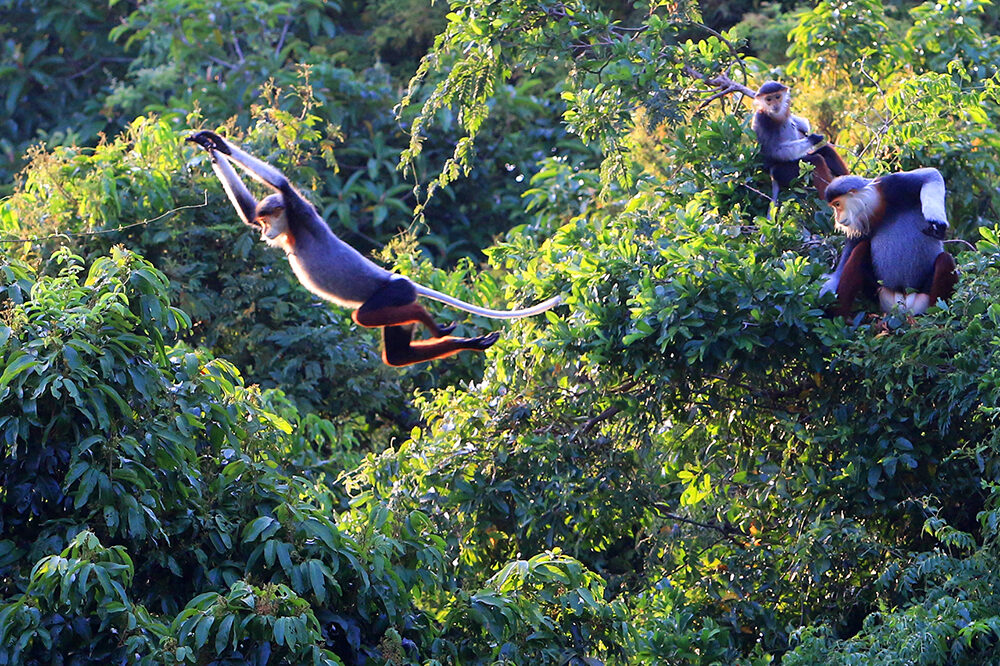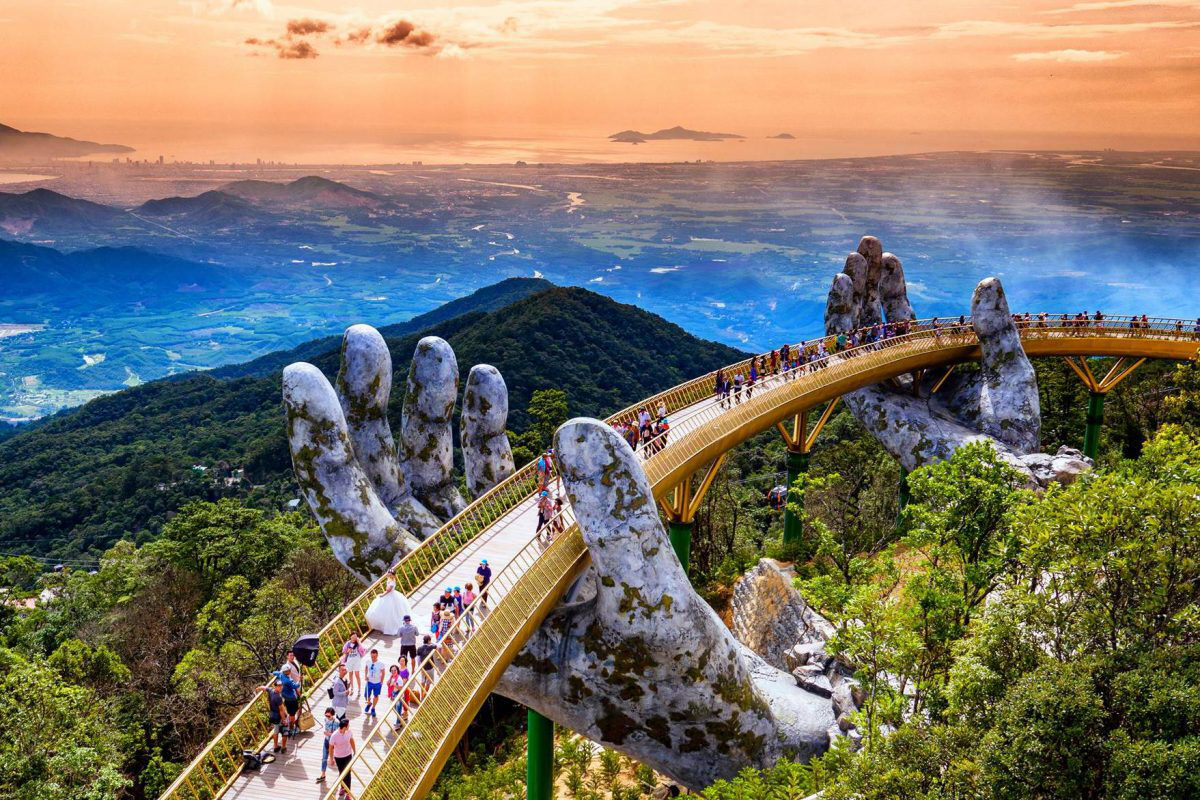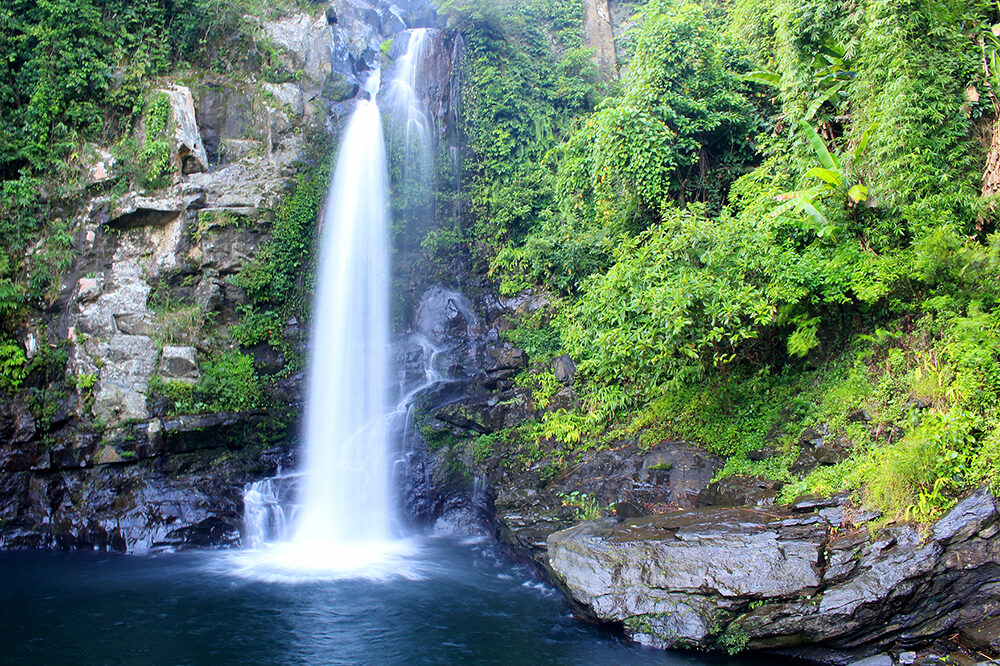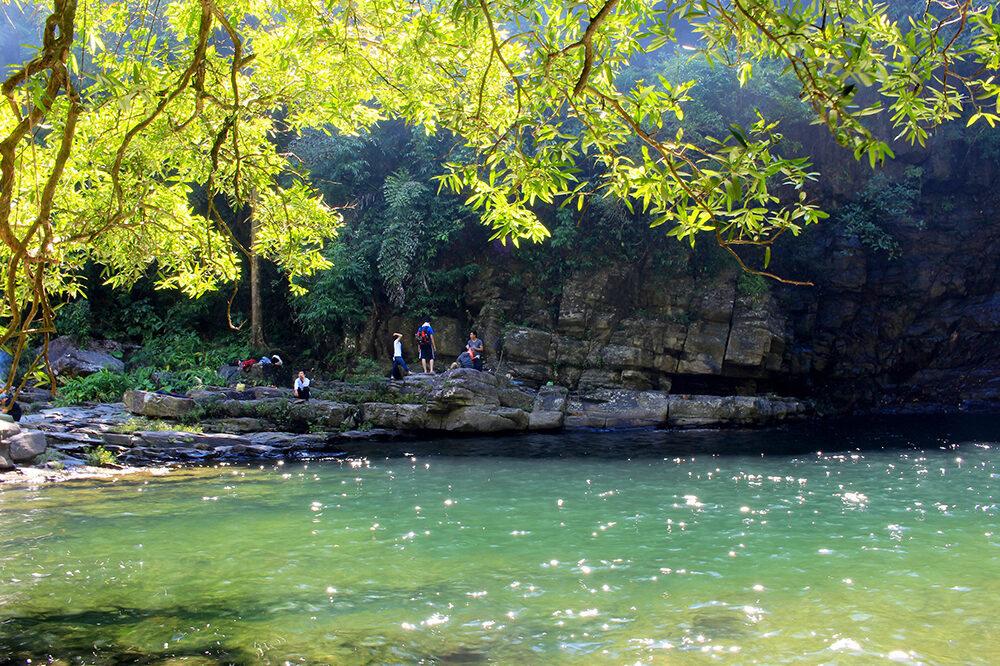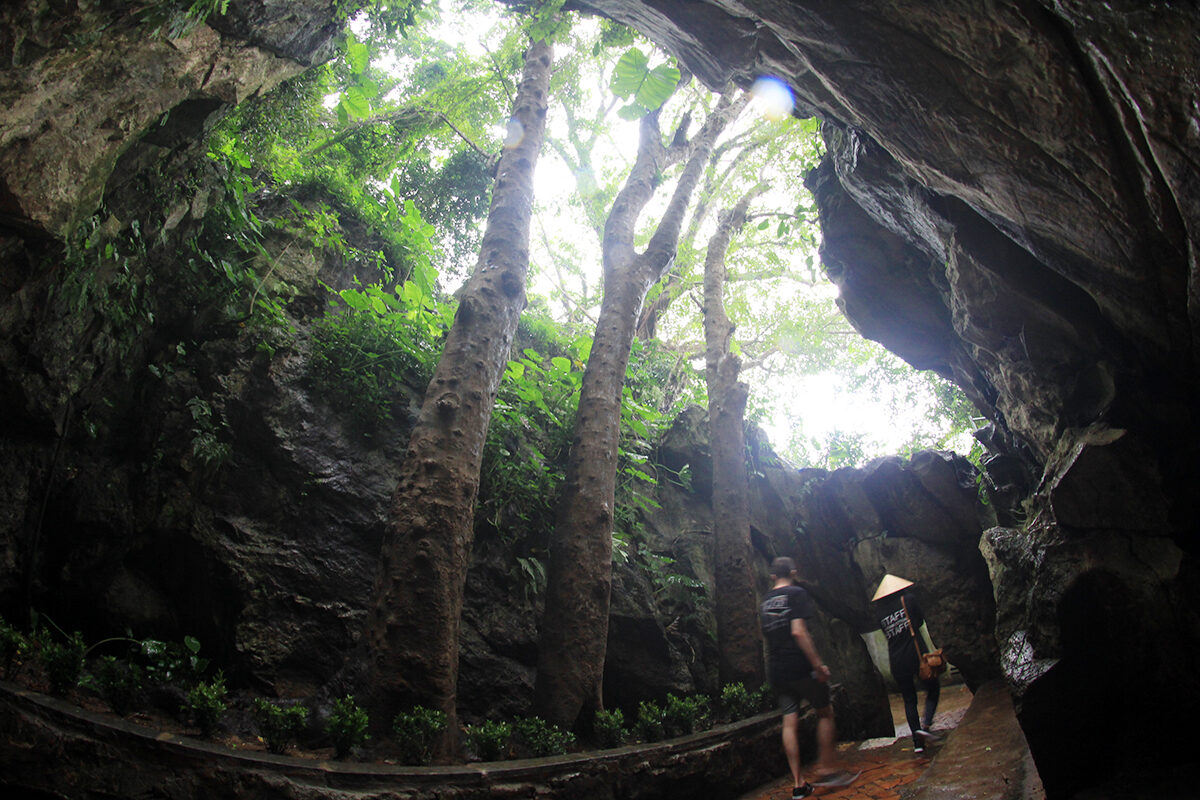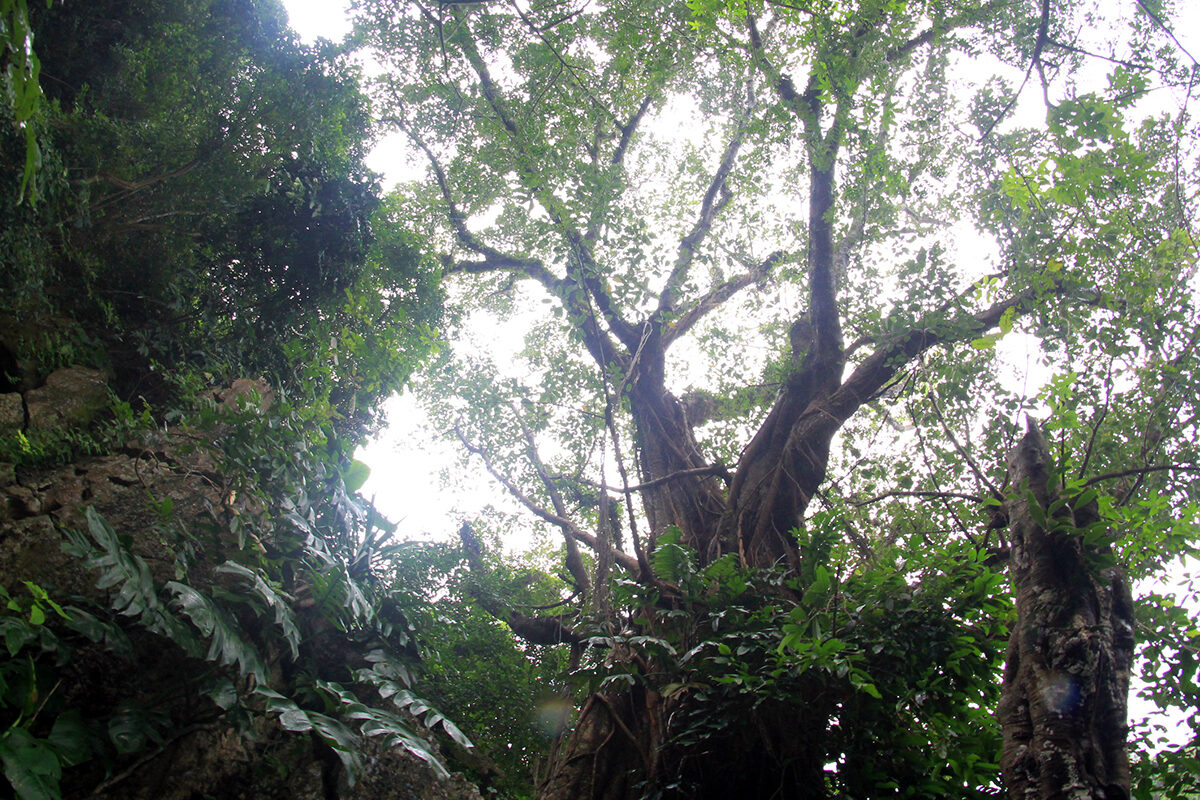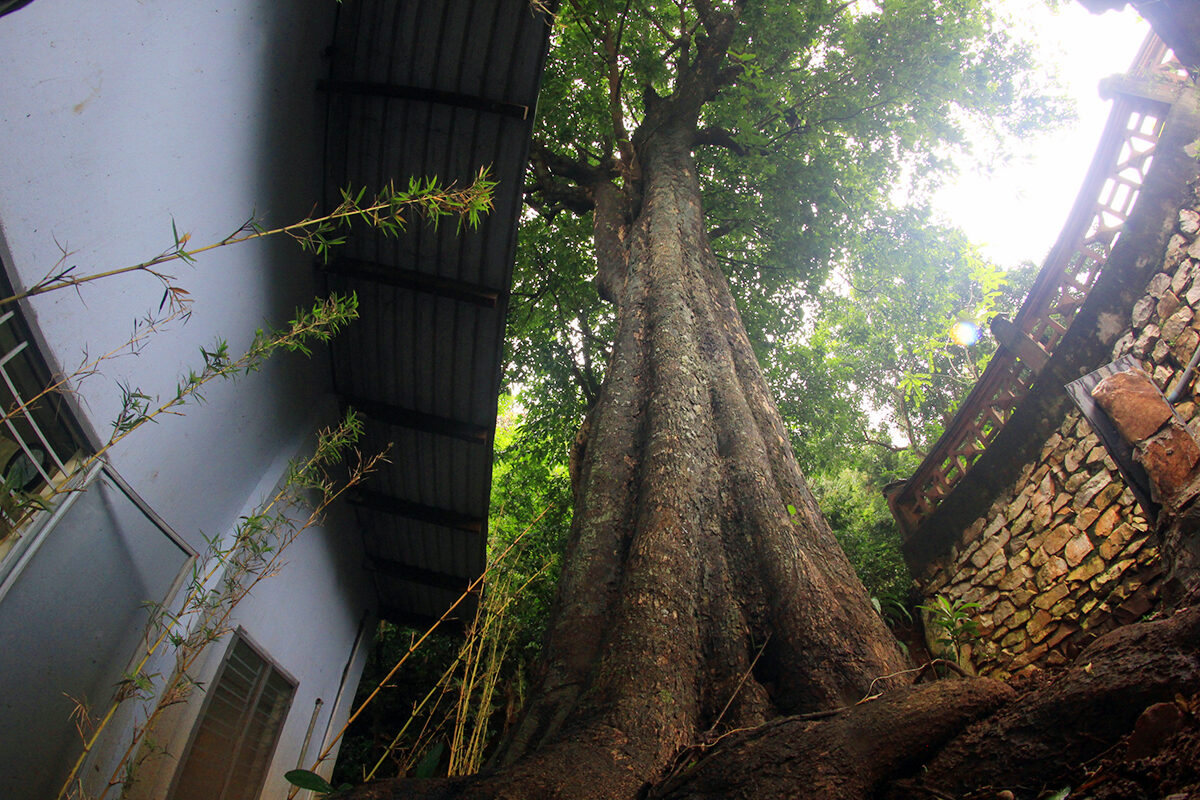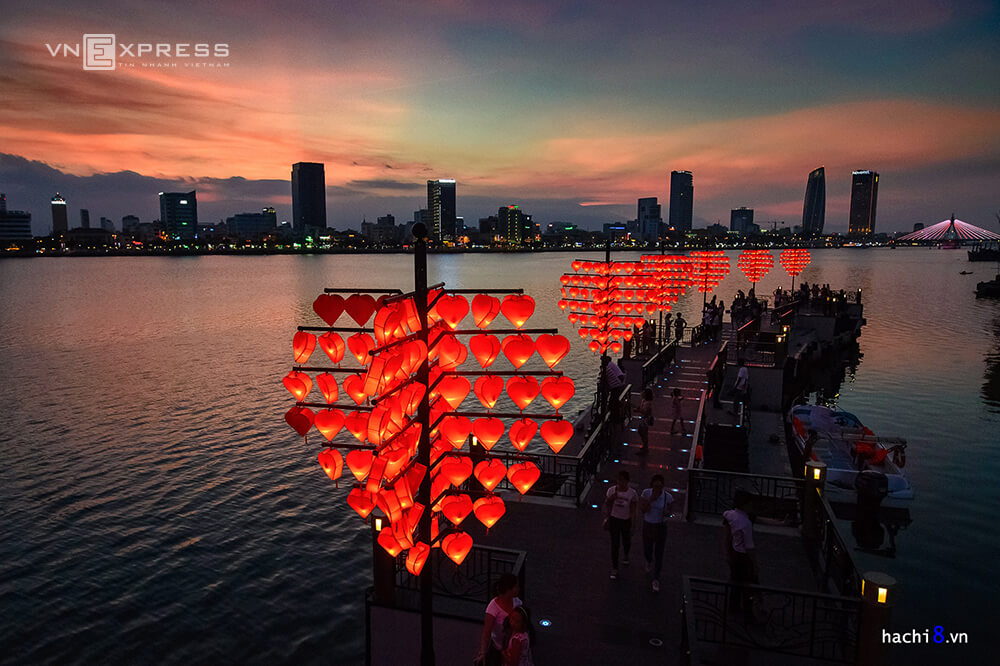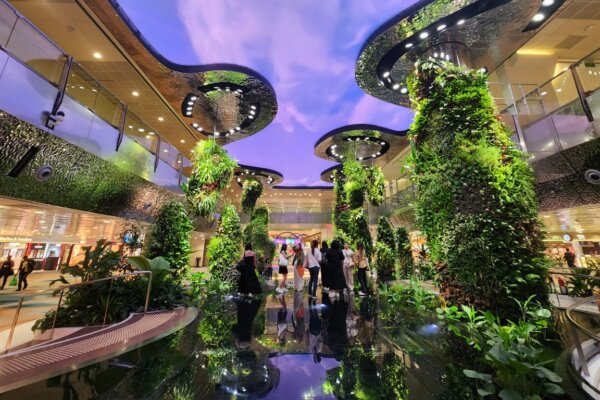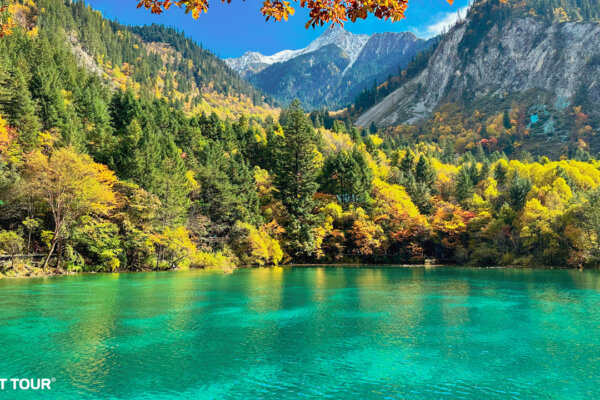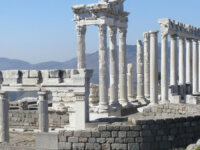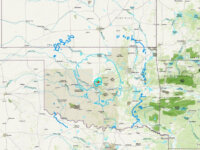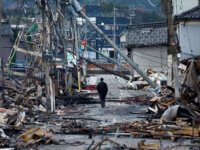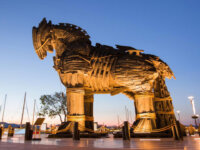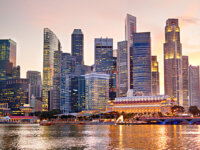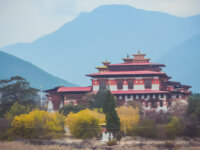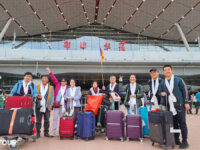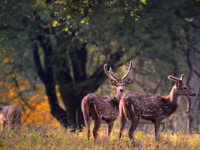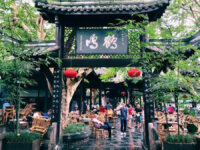VIETNAM – Da Nang city is located in Central Vietnam, equidistant from the capital city of Hanoi and Ho Chi Minh City. Da Nang is also the hub of three UNESCO World Heritage Sites: the ancient capital of Hue, the old town of Hoi An, and the holy site of My Son. To the north of Da Nang is Thua Thien – Hue Province, to the west and south is Quang Nam Province, and to the east is the East Sea.
When is the Best Time to Visit Da Nang?
Da Nang serves as a transition point between the climates of northern and southern Vietnam, with the predominant tropical climate of the south. There are two distinct seasons each year: the dry season from January to July and the rainy season from August to December. Occasionally, there are short and not too harsh cold spells in the winter, but the cold is not severe.
Late December to late March: The weather is cool and pleasant, making it ideal for spring trips. Hotel and dining prices during this time are considered the most stable throughout the year. However, travelers should bring a light jacket as evenings can get chilly, and there might be occasional spring showers.
Early April to mid-September: This is the best time to visit Da Nang, but it’s also the peak summer tourism season, so it can be crowded and expensive. In April, the forests on Son Tra Peninsula change their leaves to yellow and red.
Mid-September to late December: The weather is no longer scorching hot, and occasional drizzles begin, but they don’t last long. The peak season is over, so flight tickets, accommodations, and dining are reasonably priced.
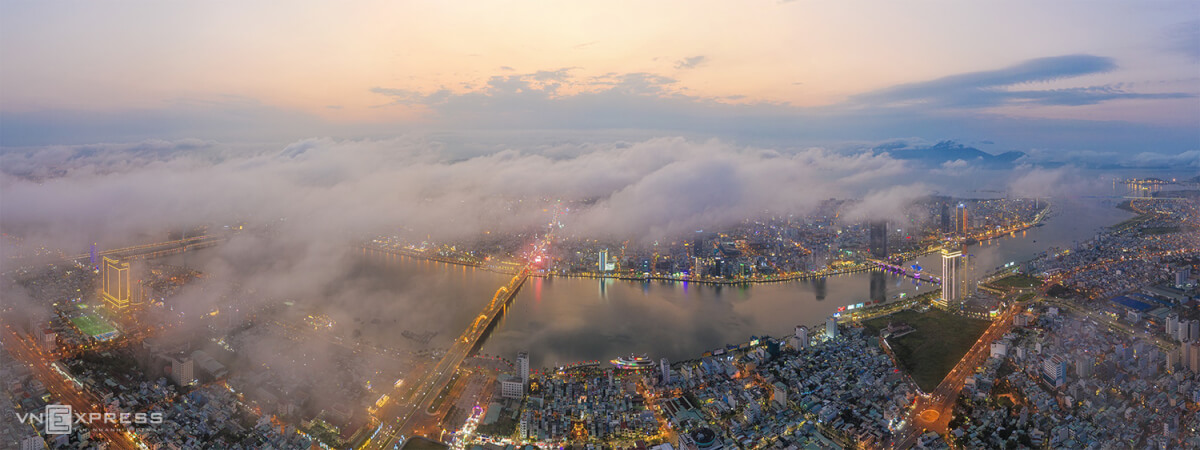
Da Nang in the mist. Photo: Nguyen Sanh Quoc Huy.
Transportation
Travelers from Hanoi and Ho Chi Minh City typically fly to Da Nang, with ticket prices ranging from 54,04 USD to 124,71 USD for a round trip, depending on the booking time. The flight takes approximately 1 hour.
For those with more leisurely time, you can take the train to experience the scenery along the way, especially the section passing through Hai Van Pass if you’re traveling from the north. Train tickets from Hanoi or Ho Chi Minh City to Da Nang cost between roughly 24,94 USD to 45,73 USD for a one-way journey, depending on whether you choose a soft, air-conditioned seat or a sleeper berth in a four-berth air-conditioned cabin. The travel time is about 17 to 18 hours.
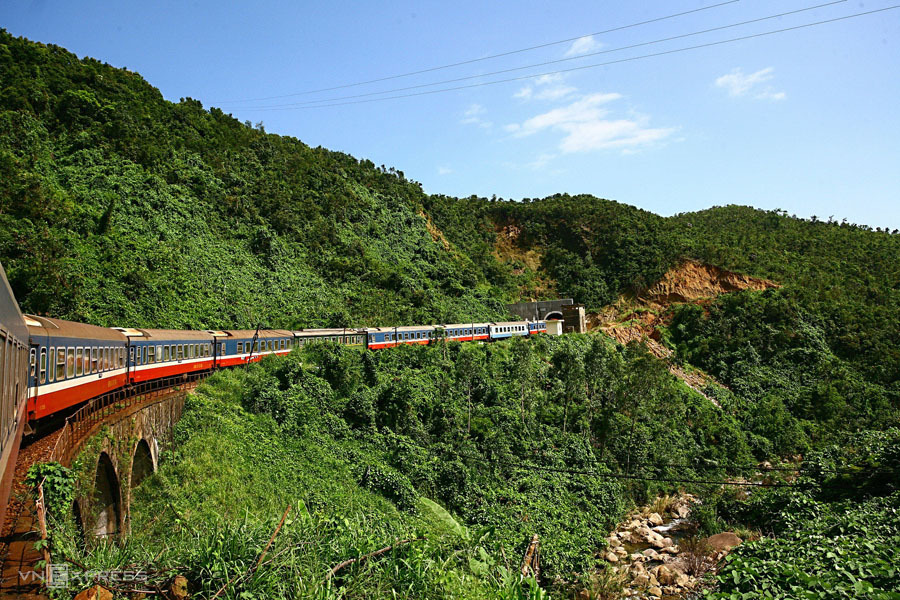
A train running through the Hai Van Pass railway. Photo: Ha Thanh.
If you plan to drive by car, you should allocate at least a week for your Da Nang trip and have two drivers take turns behind the wheel. Ideally, you should start from Hanoi around midday or early afternoon, spend a night in Nghe An. If you depart later, you can sleep in Thanh Hoa and head to Da Nang the following morning. On the way back, you can stop in Quang Binh for both rest and further exploration.
In Da Nang, it’s advisable to rent a motorcycle or a car for flexible transportation. Renting vehicles is quite convenient and can be arranged at the airport or your hotel, with an average cost of 4,16 USD for a motorcycle and around 41,57 USD for a car per day.
Hotels and Resorts
Tourism in Da Nang has been growing rapidly. Along the coastal road, travelers can easily find hotels with various price ranges. Additionally, Da Nang offers various types of accommodations such as homestays, apartments, and dormitory-style rooms in the city center. Depending on your budget and preferences, travelers can choose what suits them best, but it’s advisable to book in advance to avoid room shortages during weekends and peak seasons.
Since the weather in Central Vietnam can be quite chilly at night during the early part of the year, travelers should consider staying in fully equipped rooms with amenities like private bathrooms, hot water facilities, hairdryers, ironing boards, and laundry services. The prices for 4-star hotels start at around 20,79 USD per night.
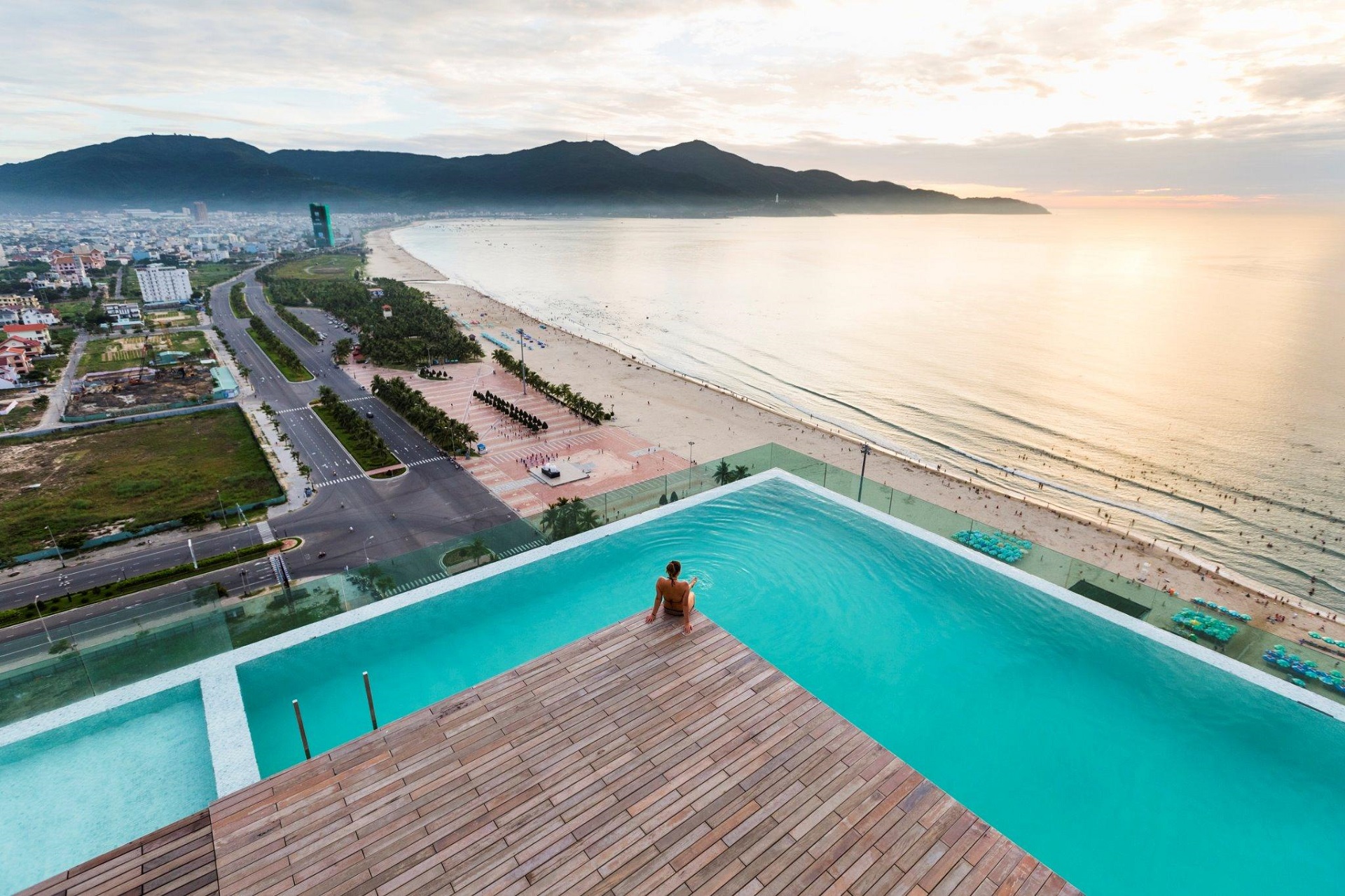
The A La Carte Hotel features an infinity pool with a view of the sea. Photo: ALC.
Some renowned 5-star resorts and hotels in Da Nang that you can consider include InterContinental Da Nang Sun Peninsula Resort, Hyatt Regency Danang Resort and Spa, Pullman, Furama Resort Danang, Four Points by Sheraton Danang, Novotel, Hilton, Fusion Suites, and Danang Golden Bay Hotel. Room rates at these establishments range from 49,89 USD to 415,71 USD per night.
Playing place
Outside the city
Beautiful destinations outside the city of Da Nang include Son Tra Peninsula, Marble Mountains (Ngu Hanh Son), Nam O Reef, and Hai Van Pass.
Son Tra Peninsula
Often referred to as the precious gem of Da Nang, Son Tra Peninsula boasts vast pristine forests and beautiful beaches such as Tien Sa, Da Den, and Bai But. The winding road along the peninsula offers panoramic views of the city from high points like Ban Co Peak, Linh Ung Pagoda, Vong Canh House, Son Tra Lighthouse, and the “Eastern Eye” radar station.
Here, travelers can engage in various exciting activities, such as snorkeling to explore coral reefs, fishing with local fishermen, helicopter tours for cityscape views, and hiking to Ban Co Peak. Especially, the Linh Ung Pagoda perched atop a hill is a must-visit spot. It houses the tallest statue of Quan The Am Bodhisattva in Vietnam, facing the sea. Inside the statue, there are 17 floors, each containing 21 Buddha statues with different postures and expressions.
On the peninsula, there are side roads leading to beautiful beaches like Bai But, Bai Nam, Bai Da Den, Bai Da, and Mui Nghe. Additionally, this area is known for the Son Tra banyan tree and the “thousand-year-old deer” banyan tree, both with unique shapes that are perfect for photography.
The peninsula is also home to hundreds of species of wildlife. Among them, the red-shanked douc langur is known as the “queen of primates” on Son Tra Peninsula, with a population of around 300 to 400 individuals, strictly protected. To spot these douc langurs, besides observing their fur colors, travelers should also listen for their calls and watch for their agile movements as they leap from branch to branch.
Please note that visitors should help preserve the natural landscape and refrain from feeding wild animals. Scooters are not allowed on certain roads, including the section from Hoang Sa Street to the thousand-year-old banyan tree, the Yết Kiêu Road intersection to Ban Co Peak – Bac Beach, and the Yết Kiêu Road intersection to Suoi Om and vice versa. These are the three main routes that residents and tourists frequently take to visit Son Tra Peninsula. Manual and automatic motorcycles are allowed.
Furthermore, Son Tra Peninsula is alluring for its pristine beaches. Tucked away in a beautiful bay, Bai But (Vinh But) is a place where the sea meets the mountains. There is also Bai Bac, a newly developed destination in Da Nang tourism, located in the northern part of Son Tra Peninsula. The sea around the peninsula features many beautiful coral reefs, but littering and some irresponsible behaviors of coral admirers such as stepping on, kicking, or breaking them have caused serious damage.

Statue of Bodhisattva Avalokiteshvara (Guanyin) at Linh Ung Pagoda – Bai But, facing the peninsula, approximately 10 km from the center of Da Nang. Photo: Vo Van Viet.
Suoi Tien
Suoi Tien is one of the major streams originating from the peak of Son Tra, which is one of the picturesque destinations with its pristine waterfalls, unique rock formations, blossoming wildflowers, and intoxicating fragrances. When you visit Suoi Tien, you’ll immerse yourself in the stunning and colorful beauty of nature.
Ba Na Hills
This tourist spot is approximately 40 km away from Da Nang. Visitors can experience cool weather and four seasons in a day when exploring prominent attractions such as Linh Ung Pagoda, Debay Wine Cellar, Le Jardin D’Amour flower garden, and the Golden Bridge. Spending the night in the French Village is also an intriguing experience for travelers to Ba Na.
Heaven’s Well
Located within the Ba Na – Nui Chua Nature Reserve, Heaven’s Well offers a pristine natural landscape that serves as inspiration for backpackers who enjoy outdoor activities such as trekking, mountain climbing, camping, and river bathing.
Starting from the parking lot of the Ba Na cable car station, adventurers must conquer a winding and steep 7.5 km road, crossing icy streams and dense forests. Once you pass the initial steep ascent, the rest of the journey is relatively easy. This isolation adds to the charm of the place. Two streams from the western side of the Ba Na forest converge at a mountain pass and then flow down into Heaven’s Well.
Marble Mountains (Ngu Hanh Son)
Located 8 km from the center of Da Nang, the Marble Mountains is a place with numerous sacred temples and natural caves. Along the coastal road that leads to Hoi An, travelers will encounter the “Five Elements Mountains,” also known as Marble Mountains. These mountains, named after the five elements (Kim Son (gold), Moc Son (wood), Thuy Son (water), Hoa Son (fire) and Tho Son (earth)), each hold their own legendary stories and mysterious beauty.
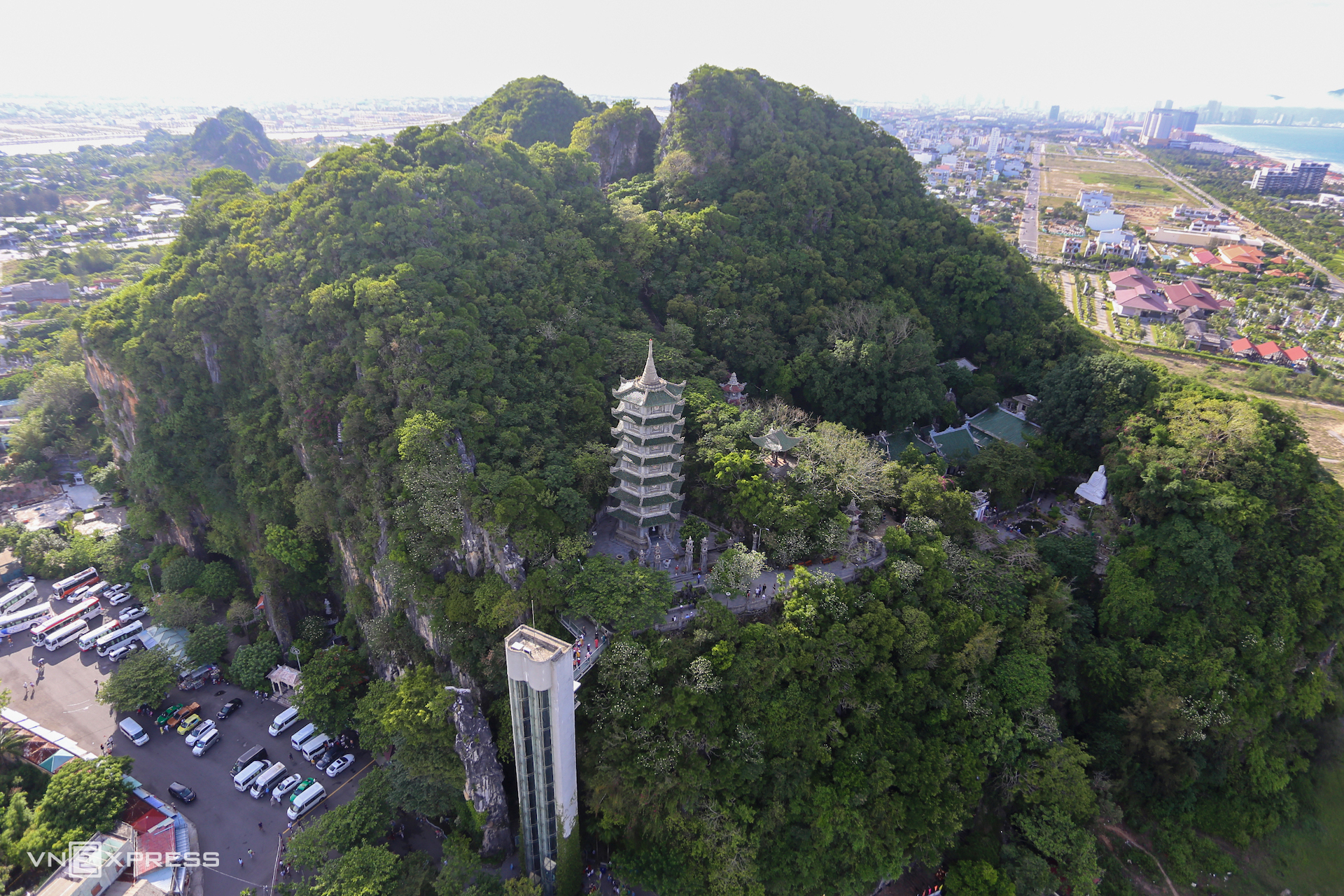
To explore all the caves and temples from Quan Am Cave (Kim Son), Huyen Vi Cave (Hoa Son) to Am Phu Cave, Hoa Nghiem Cave, Linh Nha Cave, Huyen Khong Cave, Van Thong Cave, Thien Long Cave, and Thien Phuoc Dia Cave (Thuy Son), it may take you several days. Although not grandiose, the Marble Mountains offer diverse emotional experiences thanks to their sacred and mystical beauty.
Following the winding mountain paths in the Marble Mountains, travelers will unexpectedly come across various caves and temples. In Kim Son, there is Quan Am Temple and Quan Am Cave; in Hoa Son, there are Linh Son Temple, Huyen Vi Cave, Pho Da Son Temple, and Pho Da Cave; in Tho Son, there are Long Hoa Temple and Hue Quang Temple; in Thuy Son, there are Tam Thai Temple, Linh Ung Temple, Tam Ton Temple, and Tu Tam Temple.
Most of these temples are nestled against the mountains, and while not particularly high, they exude a serene and sacred atmosphere. Along with the gentle sea breeze and the lush greenery of the mountains, trees, and vegetation, travelers can easily sense a realm of tranquility and serenity.
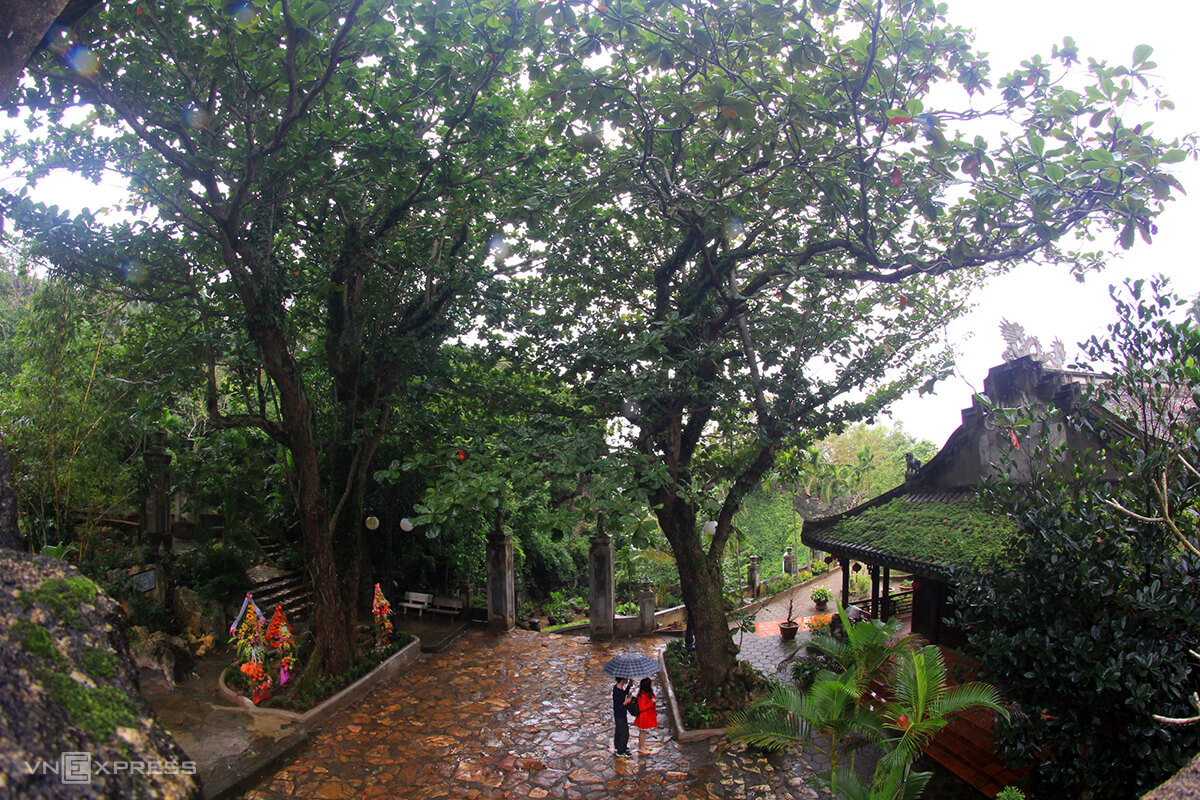
The famous Marble Mountains with seven heritage trees. Photo by Nguyen Đo.
Furthermore, if you seek adventure, you can experience mountain climbing in Van Thong Cave or rappelling from the mountain peak at a height of 25 meters.
Hai Van Pass
Hai Van Pass is approximately an hour’s motorbike ride from the center of Da Nang. The pass spans 21 kilometers, with its highest point at 496 meters above sea level. “Hai Van” translates to “Sea of Clouds,” and this location was once famously described by Jeremy Clarkson, host of the reality TV show Top Gear (UK), as “one of the most beautiful coastal roads in the world“.
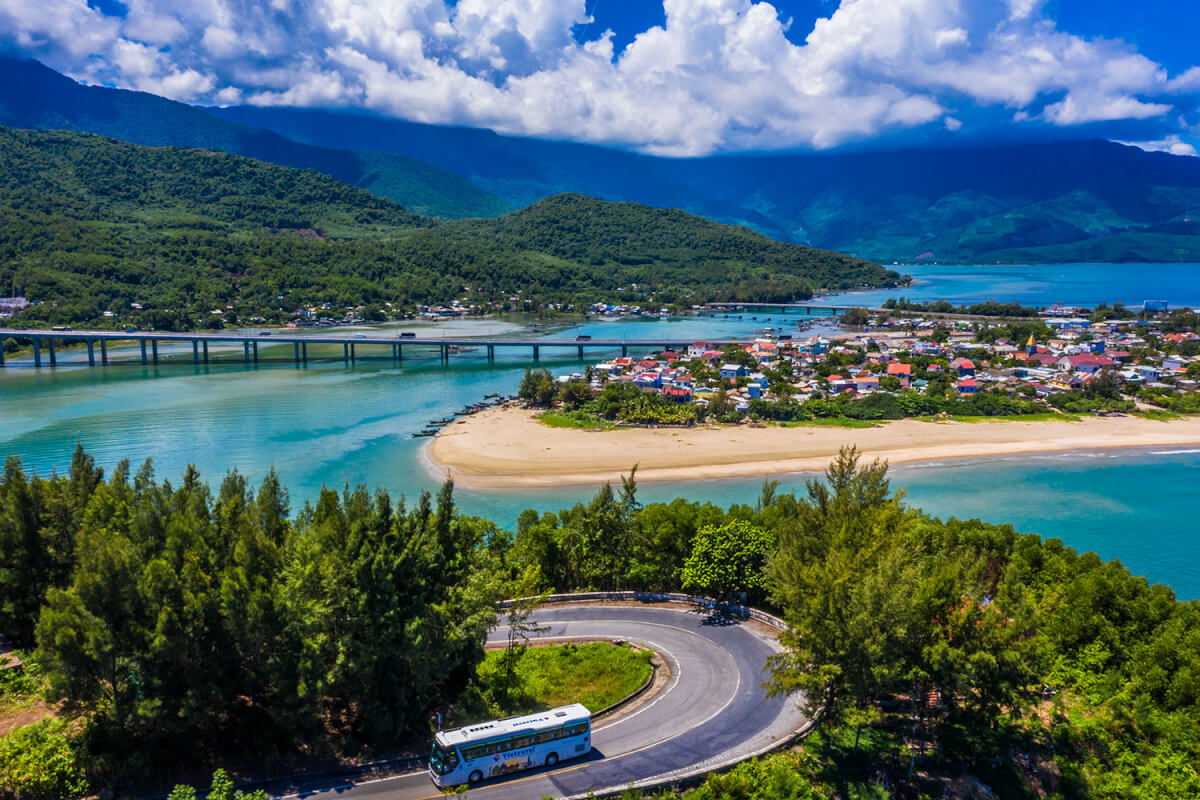
A hairpin turn on the Hai Van Pass. Photo by Vietravel.
Currently, there are two routes across Hai Van Pass: the Hai Van Tunnel (not suitable for motorbikes) and the Hai Van Pass road.
The Hai Van Tunnel is open daily and has a toll fee. The tunnel is closed for maintenance and cleaning between 3 AM and 4 AM daily. If you take the tunnel route, you won’t be able to enjoy the scenic views or visit some of the famous spots along Hai Van Pass.
The Hai Van Pass road is open daily and is free of charge. Travelers should choose this route if they want to experience the thrill of conquering the pass and enjoy unrestricted scenic views. However, it’s essential to reduce speed when there is fog.
During the New Year’s period, travelers can capture “cloud hunting” photos at the famous hairpin turn, Hai Van Quan Peak, the “above the clouds” garden opposite Hai Van Quan, or head down to Lang Van for a beach experience. The ideal times for sightseeing are at dawn or dusk.
Rolling white clouds passing over the mountains. Video by @utcuong1998/TikTok.
Nam O Reef
Located approximately 17 km from the city center, Nam O Reef is in Hoa Hiep Nam Ward, Lien Chieu District, Da Nang. The name “Nam O” historically referred to the southern gateway of Dai Viet, dating back 700 years. It’s a densely populated area where most residents are engaged in fishing and net making. Nam O is also renowned for its traditional craft of making fireworks and fish sauce.
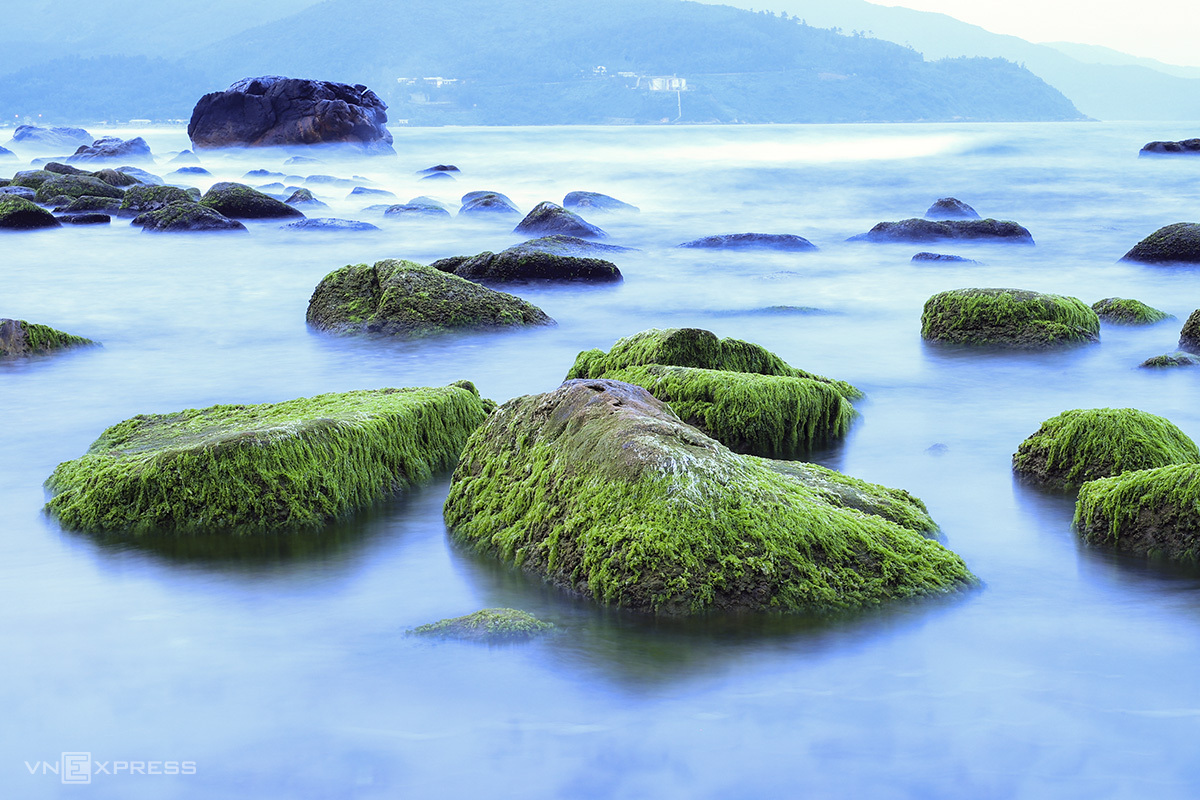
Photo: Nguyen Dong
This long stretch of rocks, covered in lush green moss, lies by the seashore. Sunset and sunrise are the two times when many people visit the rocky shore to capture stunning photographs. In this area, you can also savor the specialty dish “goi ca Nam O” (Nam O fish salad) and the famous Nam O fish sauce, which has been passed down through generations in this fishing village.
Ghenh Bang
Ghenh Bang has become a famous destination among backpackers in Da Nang for about three years now. It’s situated on the Son Tra Peninsula, approximately 15 km from the city center, following the Hoang Sa Road. Ghenh Bang, along with Mui Sung, Mui Nghe, Golden Sand Beach, and Black Rock Beach, creates captivating natural landscapes that attract travelers to explore.
With a 2 km coastal road, Ghenh Bang features flat sandy beaches, small and large rock formations jutting into the sea, and coral reefs. Travelers who visit Ghenh Bang often prepare firewood, light snacks, and drinks for camping or day trips.

Photo: Huynh Nhi
Craft Villages
Located 14 km southwest of Da Nang city center, Cam Ne Bamboo Village is situated in Hoa Tien commune, Hoa Vang district. This place has long been famous for its traditional bamboo crafts, which were once present in the royal court of the Nguyen Dynasty.
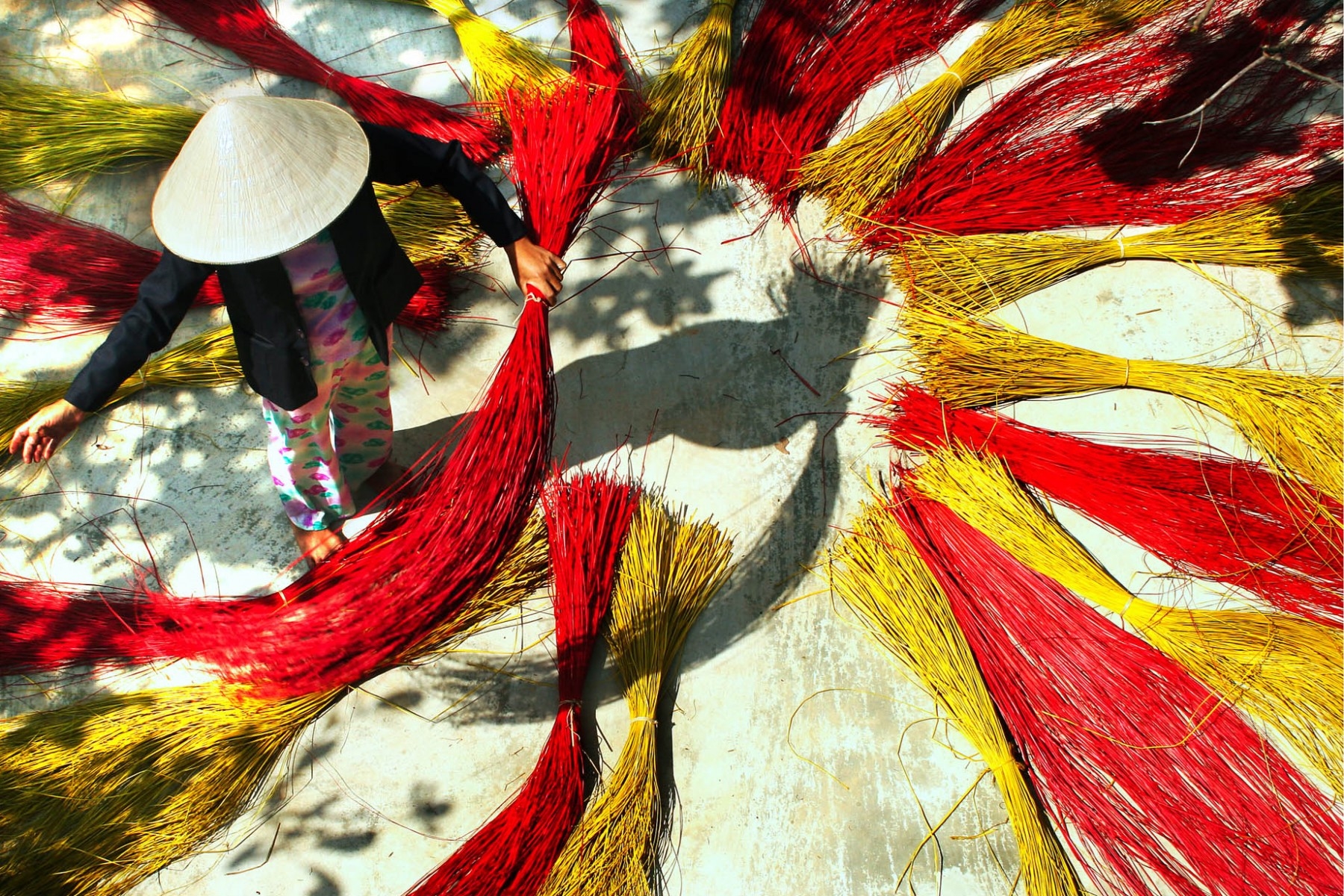
Photo: Danang City Tourism Information Portal.
Tuy Loan Rice Paper Village is located in Hoa Phong commune, Hoang Vang district, about 15 km from the city center. This village, over 500 years old, is suitable for those on a journey to explore the history of Da Nang. The village is renowned for its production of rice paper and Quang noodles.
Non Nuoc Stone Carving Village is located at the foot of the Marble Mountains. This traditional craft village, nearly 400 years old, is famous for its beautifully crafted stone artworks created by the skilled hands of artisans.
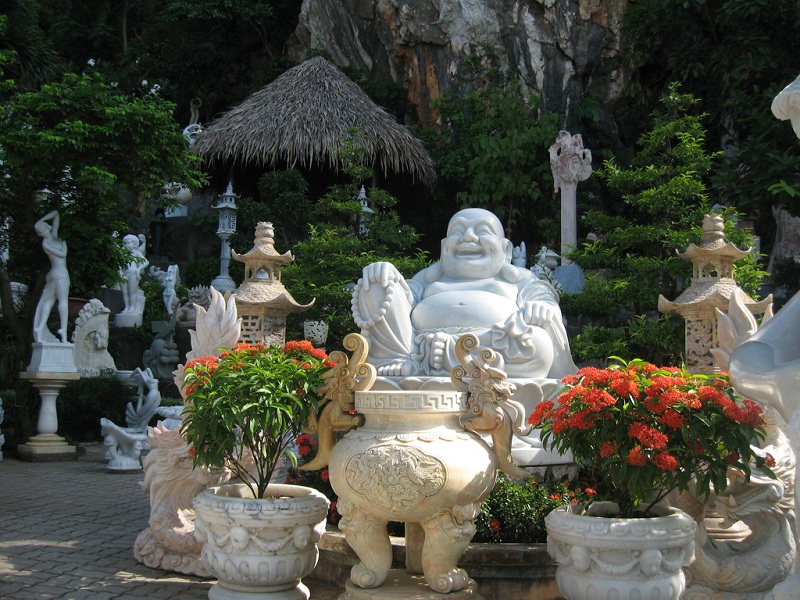
Photo: Vy An
Hoa Trung Lake
This is an artificial lake that provides water for daily use and agriculture to the residents of Hoa Lien and Hoa Son communes in Lien Chieu district. The lake is surrounded by floating islands, making it suitable for travelers who enjoy exploration, camping, and picnics. You should prepare enough food and drinks for camping overnight by the lake, but please remember to clean up and take your trash home.
Hoa Trung Lake is located 20 km from the city center of Da Nang, and it takes about 40 minutes by motorcycle to reach it. From the city, take the Au Co road (Hoa Khanh Market) towards Ba Na, and look for Hoa Ninh parish. Turn left onto a concrete road and follow it until you see a narrow trail about 30 cm wide. If you have trouble finding the way, don’t hesitate to ask locals for directions.
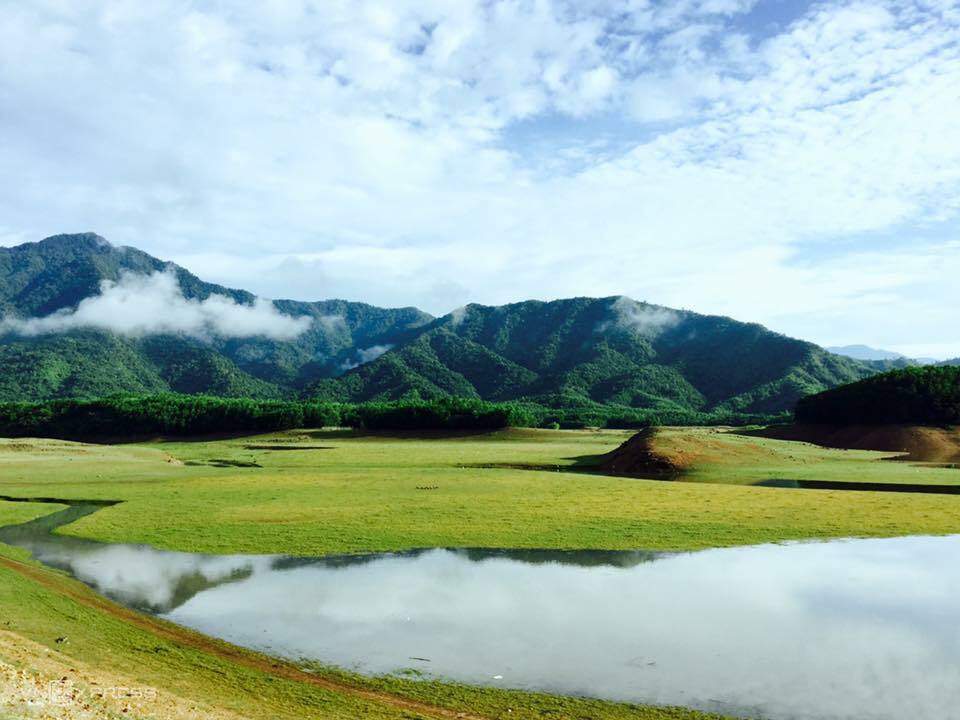
Photo: Tri Trinh
Ecotourism Areas
Some recommended destinations include Hoa Bac Ecotourism Area, Lai Thieu Ecotourism Area, Suoi Hoa Ecotourism Area, Suoi Lương – Hai Van Park Ecotourism Area, Hoa Phu Thanh Ecotourism Area, Ngam Doi Ecotourism Area, Nui Than Tai Hot Spring Park, Phuoc Nhon Hot Spring Ecotourism Area… Most of these ecotourism areas offer recreational activities, entertainment, dining, accommodation, and charge an entrance fee.

People in Da Nang camping by the Cu De River, Hoa Bac commune, Hoa Vang district. Photo: Phan Dinh.
Inside the city
The Bridges
Da Nang is known as the city of bridges in Vietnam. Dragon Bridge, Han River Swing Bridge, Tran Thi Ly Bridge, and Love Bridge are popular tourist attractions for sightseeing and checking in. Near Love Bridge, there is a statue of a carp turning into a dragon.
In particular, Dragon Bridge is crowded with visitors around 9 PM on weekend nights when it hosts a water and fire-breathing dragon show. During the 15-minute show, traffic on both ends of the bridge is halted. Tourists should choose a suitable spot or bring raincoats and umbrellas to avoid getting wet during the water show.
Video: Khoi Tran
Han River Swing Bridge is Vietnam’s first swing bridge. The bridge is 487.7 meters long, 12.9 meters wide, and has 11 spans, including two cable-stayed spans. The central part of the bridge, which is located above the river’s central support, can rotate 90 degrees parallel to the water flow to allow large ships to pass through. This bridge symbolizes the cooperation and unity between the government and the people, as the local residents of Da Nang contributed to its construction.
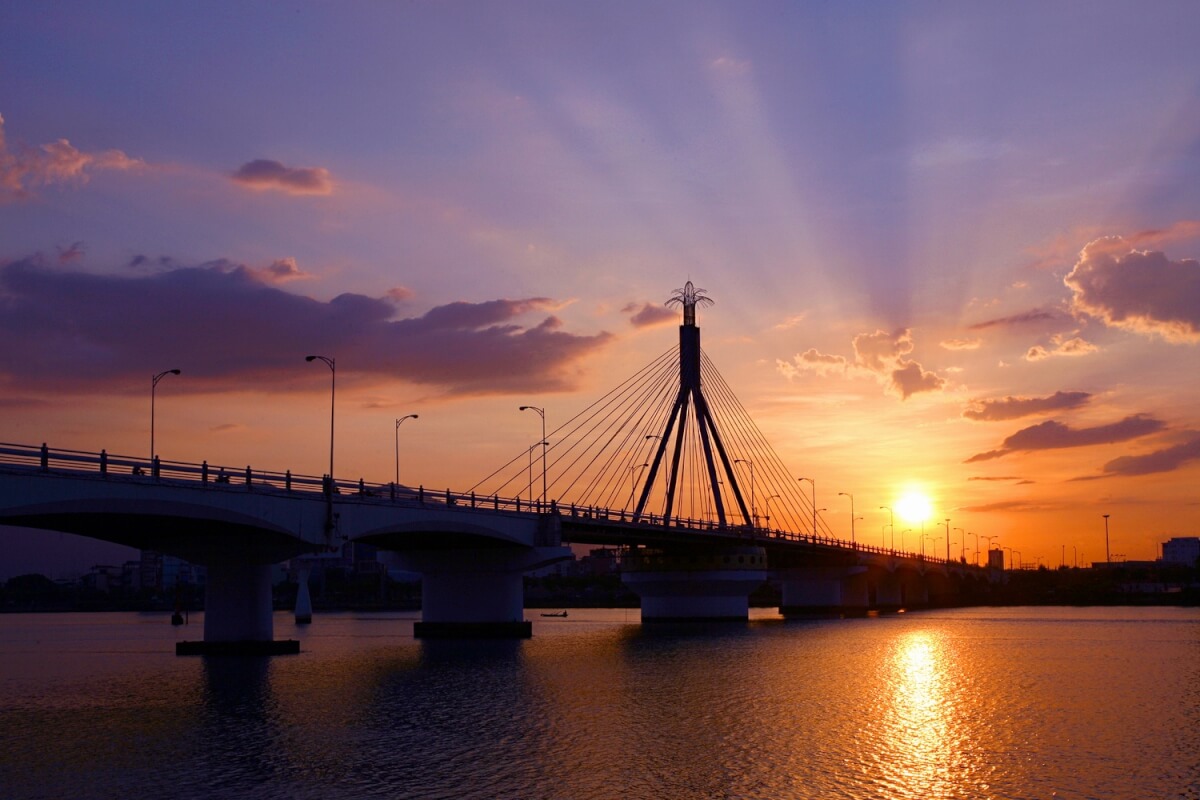
The Han River Bridge is a part of the cityscape and also appears on Danang’s street signs. Photo: Ha Thanh.
Thuan Phuoc Bridge is the largest suspension bridge in Vietnam. It stretches 1,856 meters in length and 18 meters in width, with two anchorages at both ends of the bridge and two cable-stayed towers descending into the river.
Tran Thi Ly Bridge is named after a female hero from the resistance against the United States in Quang Nam province. The bridge is located south of Dragon Bridge, about 1.5 kilometers away. There used to be an old bridge with the same name, but it has been replaced by the current modern bridge.
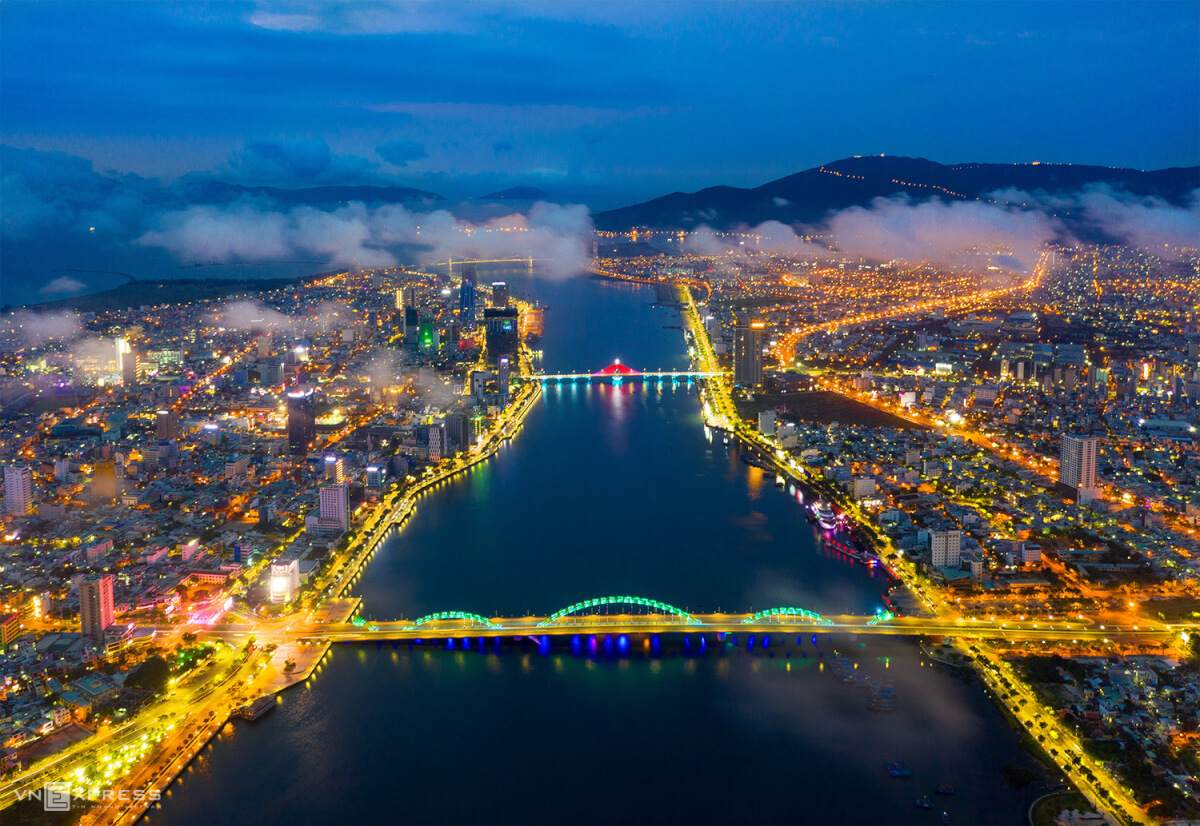
Da Nang is also known as the “City of Lights” when bridges, skyscrapers, and residential areas all light up at night. Photo: Nguyen Sanh Quoc Huy.
My Khe Beach
My Khe Beach was once voted by Forbes magazine as one of the 6 most attractive beaches on the planet and ranked among the top 25 most beautiful beaches in Asia in 2021 by TripAdvisor. The 900-meter-long beach is situated along Pham Van Dong Street, in Son Tra district. Watching the sunrise at My Khe Beach gives tourists the opportunity to learn more about the lives of local fishermen.
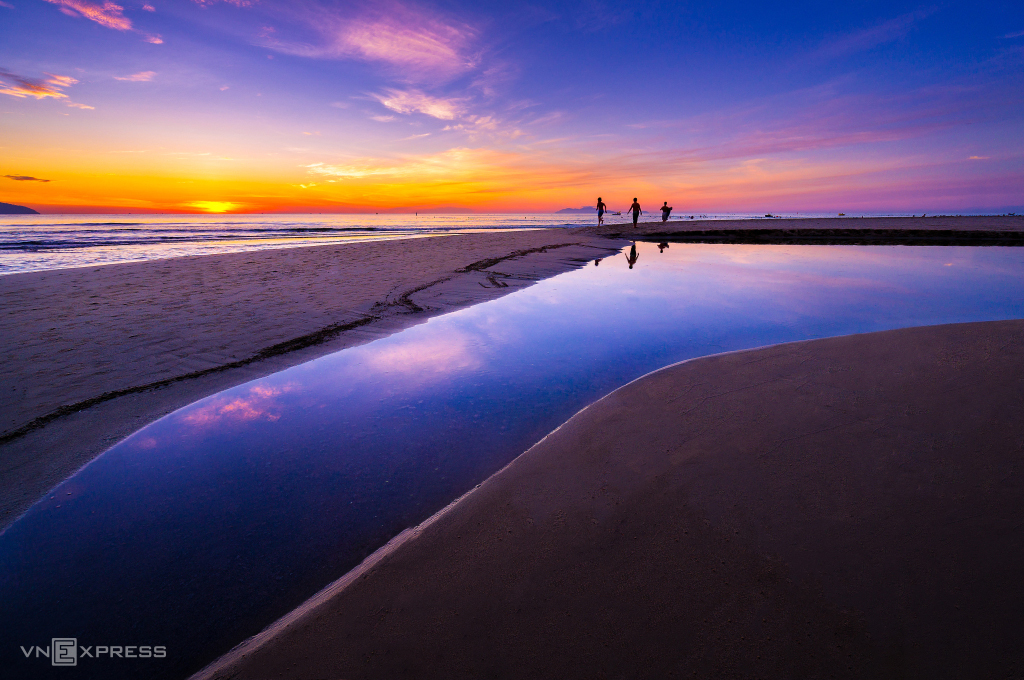
Photo: Hoang Nam Duong.
City Cultural Center for Children
Da Nang City Cultural Center for Children is a popular check-in spot among young people due to its design based on the Tangram puzzle. This structure won the National Architecture Gold Award in 2016, presented by the Vietnam Architects’ Association. Located on 2/9 Street, Hai Chau district, the center has three floors with various functional areas, play zones, entertainment, classrooms, libraries, and a hall.

Photo: Nguyen Dong
Museums
The Cham Sculpture Art Museum is located at 2 2/9 Street, Hai Chau district. It is the only museum dedicated to Cham culture, preserving artifacts from the ancient Champa Kingdom. The museum is open daily from 7 AM to 5 PM, with an entrance fee of 2,49 USD per visit. It offers self-guided audio tours and provides information about the exhibits through a 4D scanning technology application.
Da Nang Fine Arts Museum is situated at 78 Le Duan Street, Hai Chau district. The museum houses over 1,000 modern artworks, folk art items, and traditional handicrafts. It is open daily from 8 AM to 5 PM, with an entrance fee of 0,83 USD per visit (50% discount for students).
The Buddhist Museum is located within the Quan The Am Pagoda, at 48 Su Van Hanh Street, Ngu Hanh Son district. Visitors can admire over 200 ancient artifacts related to Buddhism. The museum is open daily from 7 AM to 5 PM and admission is free.

Photo: Da Nang City Tourism Information Portal.
Da Nang Cathedral
Da Nang Cathedral, also known as the Con Ga Cathedral due to the characteristic gray rooster statue on its roof, is located on Tran Phu Street. It was constructed in February 1923 on Rue du Musée (now Tran Phu Street) under the design and supervision of Father Vallet. The locals affectionately call it the “Rooster Church.”
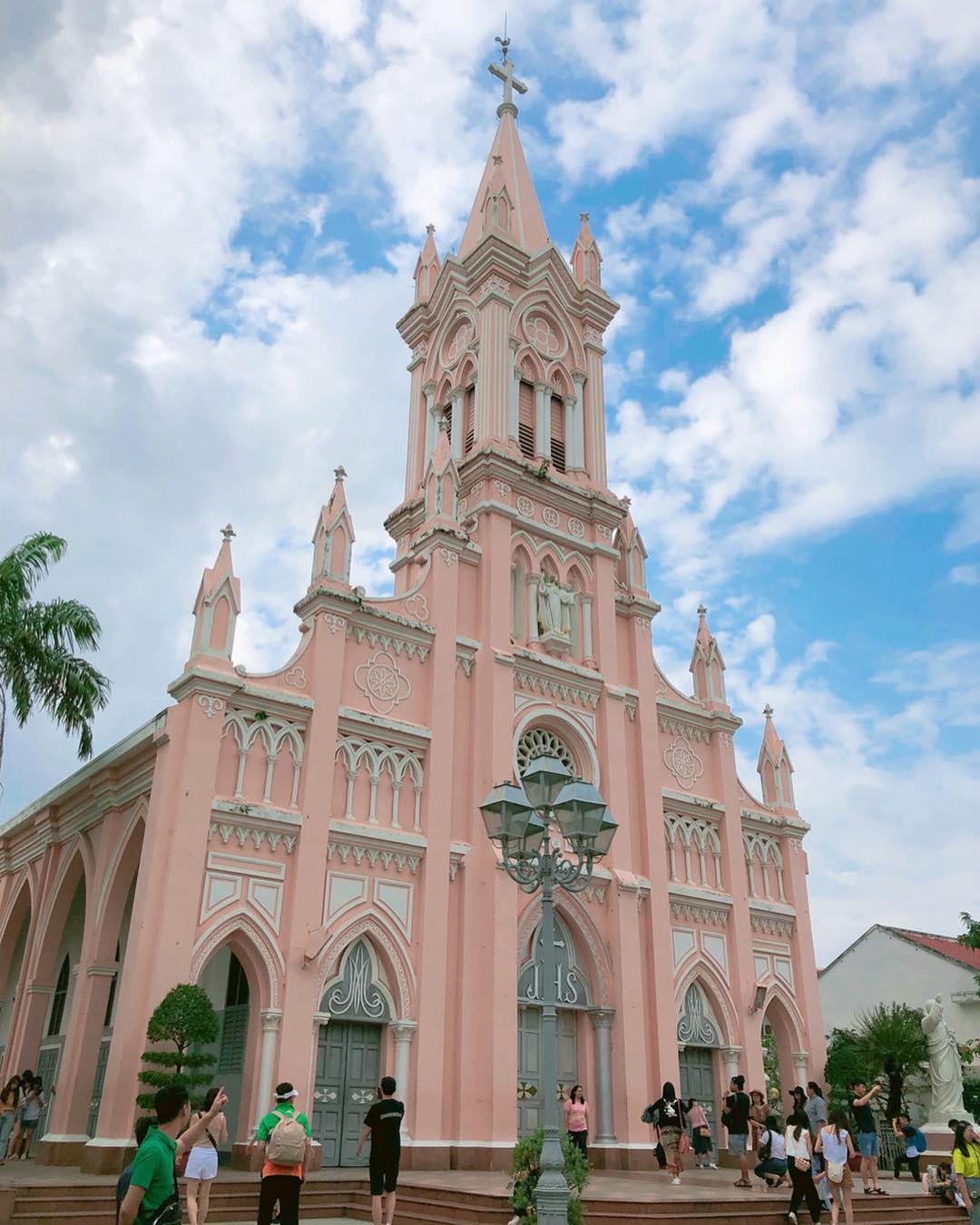
Photo: @x191225x/Instagram
Mural Alley
The Da Nang Mural Village project is located in the alley at 75 Nguyen Van Linh Street, near Dragon Bridge in Hai Chau district. The mural village is situated within an alley, but there are informative signs at the entrance. Visitors usually park outside and walk into the alley.
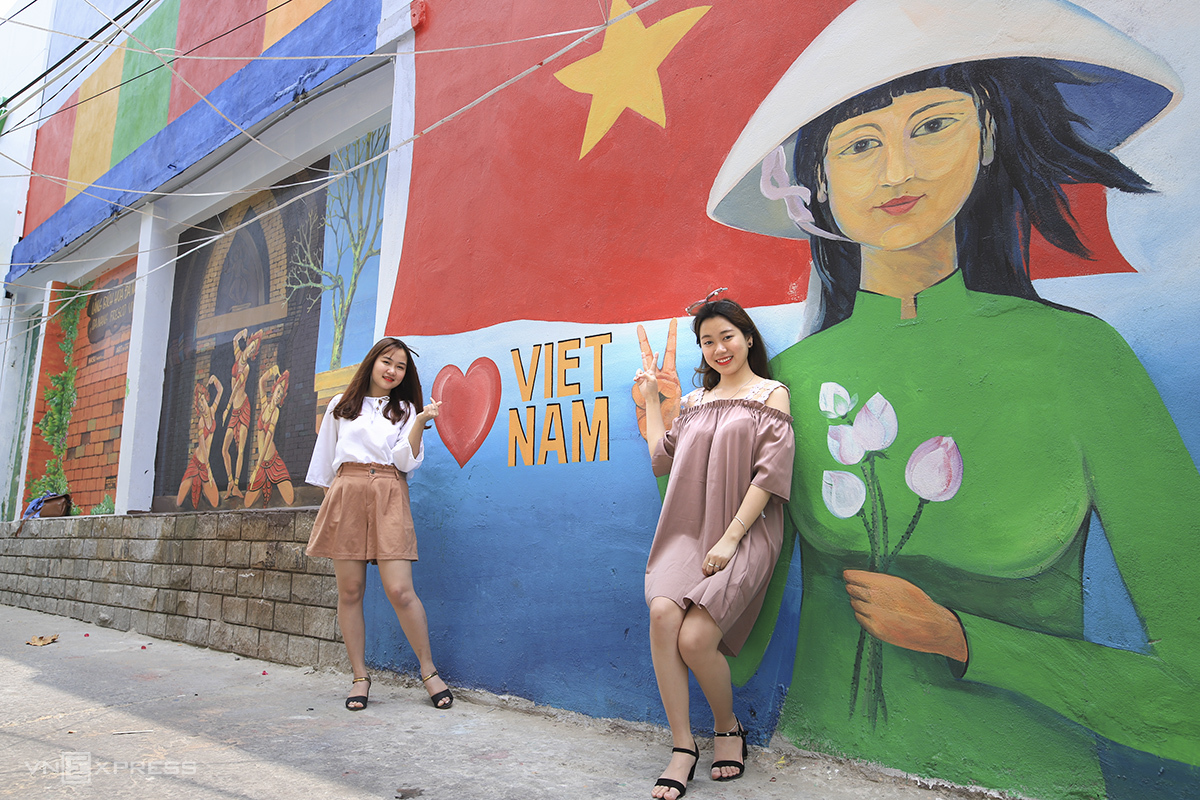
Photo: Nguyen Dong
Markets
Located on Ong Ich Khiem Street in the city center, Con Market is one of the oldest and largest markets in the coastal city. Con Market is renowned as a street food paradise with numerous stalls serving a wide variety of dishes, including breakfast and late afternoon snacks. Popular items include banh beo, banh trang cuon thit heo, mi Quang, various types of snails, and desserts, all ranging from 0,42 USD. In addition to food, you can find local specialties such as various types of fish sauce, dried squid, beef sausages, and fermented shrimp paste.
Han Market is located in the city center, near Han River Swing Bridge, surrounded by Hung Vuong, Tran Phu, Nguyen Thai Hoc, and Bach Dang Streets. The market has been in operation since the 1940s and has become increasingly bustling due to its convenient location for both road and waterway transportation.
Da Nang also boasts a variety of seafood markets, with the most appealing options being along Vo Nguyen Giap Street and the coastal areas of Son Tra district. Here, you can find stalls selling a wide range of fresh catches, from clams, snails, and crabs to fish, shrimp, and squid, all of which are highly delicious.
Furthermore, Da Nang has lively night markets such as Helio Night Market (2/9 Street, Hai Chau district), Son Tra Night Market (Ly Nam De Street intersecting with Mai Hac De Street, Son Tra district), Thanh Khe Tay Night Market (Yen Khe 1 Street, Thanh Khe district), Le Duẩn Night Market (alley 144 Le Duan, Hai Chau district), and Hoa Khanh Night Market (Nguyen Canh Chan Street). These are vibrant shopping and dining destinations that come alive in the evening, attracting both locals and tourists.
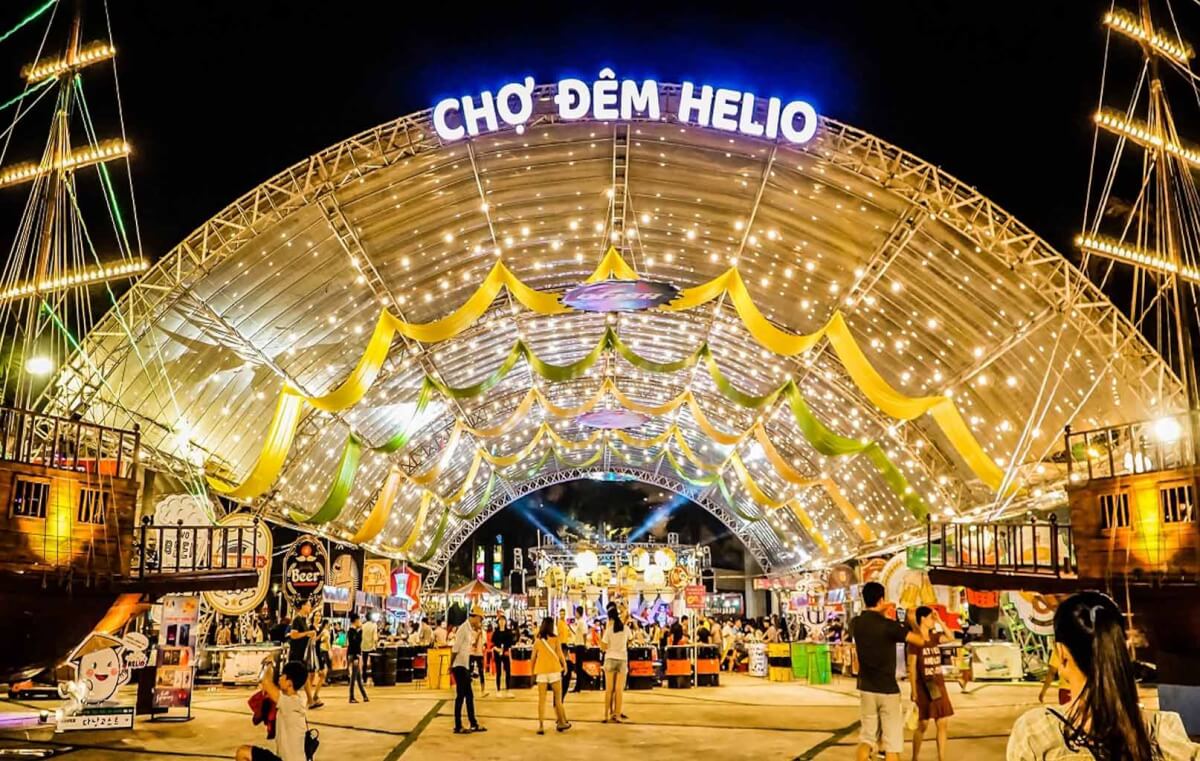
Photo: Đà Nẵng Department of Tourism.
Experiences
Viewing Da Nang from Helicopters and Planes
Helicopter tours take off from the Nuoc Man Airport, offering passengers the chance to admire the Marble Mountains from above. Afterwards, the helicopter circles around to fly over the Dragon Bridge and along the Han River, allowing tourists to take in views of the Han River Bridge, Thuan Phuoc Bridge, and the city’s impressive high-rise architecture.
Flying towards the Son Tra Peninsula, the helicopter will hover above the sea, giving you a view of the largest statue of Quan Am (the Goddess of Mercy) in Vietnam. It then circles back along Da Nang’s coastline before returning to the Nuoc Man Airport. The price for a 12-minute tour is currently 88,96 USD per person, with a 25% discount available from April 28th to July 31st, 2022.
Surfing and Stand-Up Paddleboarding (SUP)
You can sign up for surfing and stand-up paddleboarding (SUP) lessons at the Da Nang Surf School on My Khe Beach. This is the first school in Vietnam with instructors certified by the International Surfing Association (ISA). Make sure to bring swimwear and sunscreen. SUP classes are suitable for people of various fitness levels.
River Cruise on the Han River
Take a boat ride from the tourist boat dock along the Han River, where you can admire the city center at night and marvel at Da Nang’s unique bridges. The boat service offers dining, live music, and more to cater to tourists’ preferences. Some tours provide sightseeing experiences, dinner, views of the Dragon Bridge’s fire show, and more, with ticket prices ranging from 6,24 USD to 20,79 USD per person.
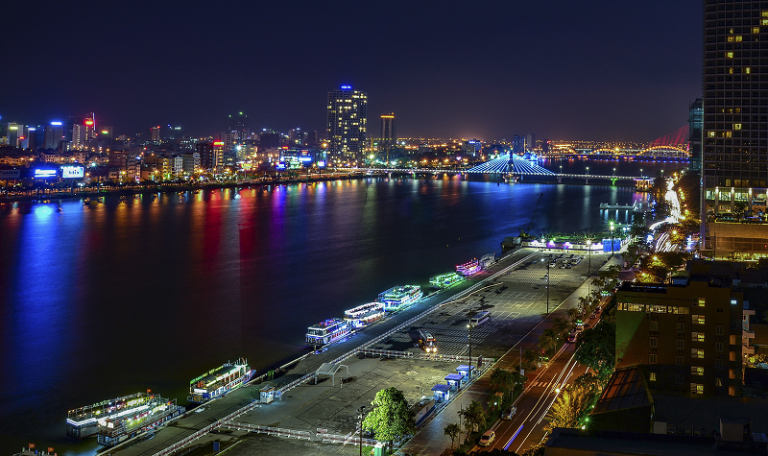
Photo: Đà Nẵng Department of Tourism.
Nighttime Fun
Da Nang is pleasantly cool in the evening, even during the middle of summer. You won’t feel the scorching heat when you step out at night. The city is not overly noisy or crowded, and the local people are friendly and welcoming. The convenience of restaurants, eateries, and bars staying open late makes it easy for tourists to enjoy dinner or sip coffee during the evening.
Local Specialties
Mi Quang
Mi Quang doesn’t have an unchanging recipe; it comes in various flavors, such as shrimp and pork Mi Quang, fish Mi Quang, crab Mi Quang, and more. Mi Quang is a dry noodle dish, and it always comes with crispy roasted peanuts and toasted sesame rice crackers.
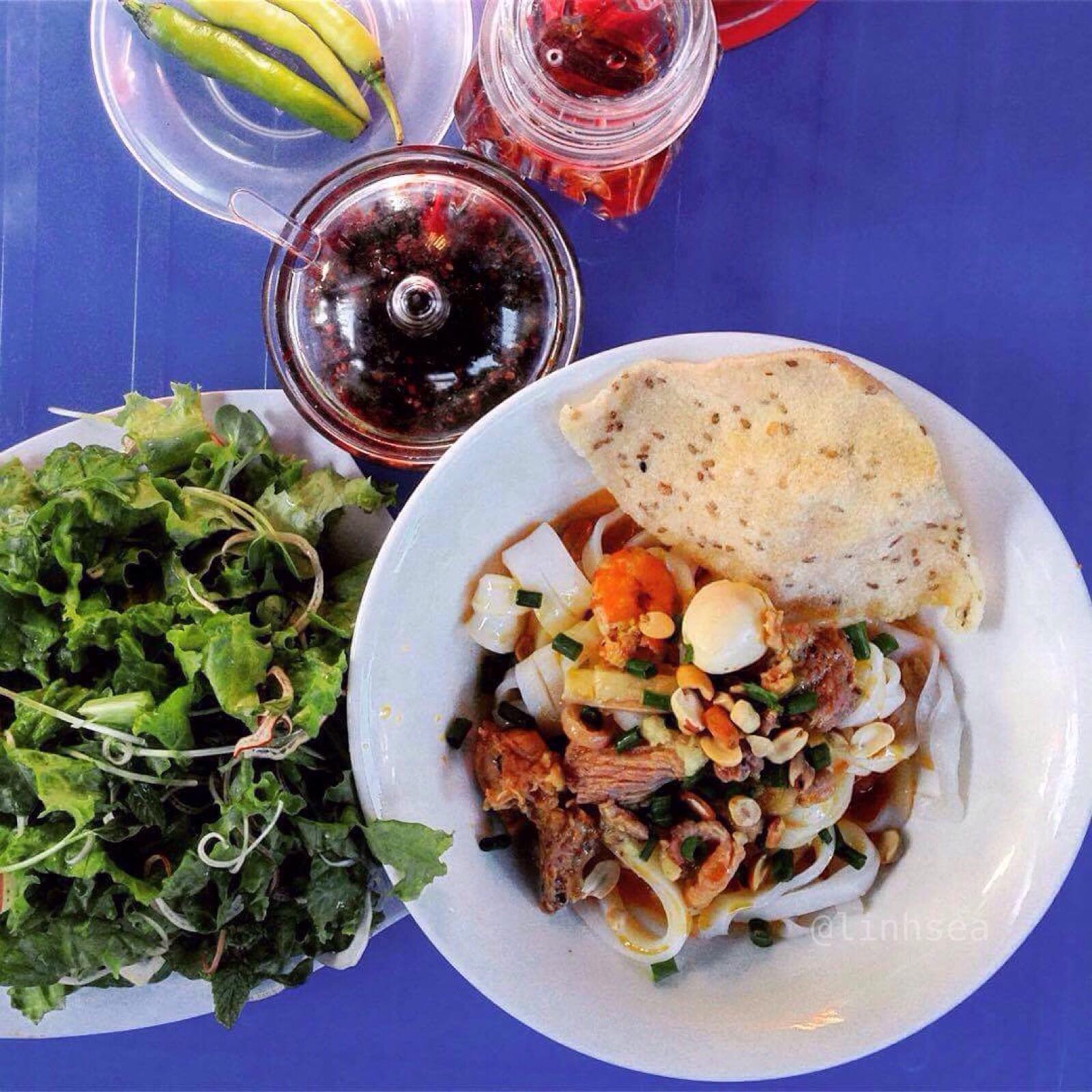
Photo: Linh Sea
If you happen to visit Da Nang on the 1st day of the lunar month, you’ll find it challenging to find pork Mi Quang. Instead, you’ll encounter vegetarian Mi Quang, made from ingredients like tofu, mushrooms, and various vegetables.
A small bowl of Mi Quang costs around 0,62 USD, while a large bowl can range from 0,83 USD to 1,25 USD. Special versions can go up to 1,66 USD.
Banh Trang Thit Heo (Pork Rice Paper Rolls)
This dish is relatively simple, but it’s all about carefully selecting ingredients to make it special. The pork is usually chosen from the loin or shoulder, and the accompanying herbs must be fresh and green, including lettuce, basil, coriander, mint, banana flowers, cucumber, green banana, and bean sprouts. The dipping sauce for Banh Trang Thit Heo is an irreplaceable element. These rolls are sold for about 2,08 to 8,31 USD per serving.
Be Thui Cau Mong (Cau Mong-style Raw Beef)
Locals in Da Nang also refer to this dish as “Bo Tai Cau Mong” or “Cau Mong-style Rare Beef.” The beef is sliced thinly and must have two layers: one that’s cooked and another that’s raw but matured. The dipping sauce is made from whole mackerel fish blended with sugar, garlic, chili, ginger, and roasted sesame seeds. When eating, you can also enjoy various fresh herbs and rice paper, much like Banh Trang Thit Heo. Be Thui Cau Mong costs between 14,55 and 15,80 USD per kilogram.
Goi Ca Nam O (Nam O-style Fish Salad)
The fish used in this dish can vary, from snakehead fish to rice-paddy eel or flathead fish, but the most delicious version is made with ponyfish. The distinct feature of Goi Ca Nam O is its dipping sauce, made from boiled fish stock combined with Nam O fish sauce, chili, tapioca starch, and seasoning. In addition to common herbs, the salad includes wild bamboo shoots, lahn ngahn (a type of aquatic herb), tram leaves, and lan flower buds, which only grow in the Hai Van Pass area.
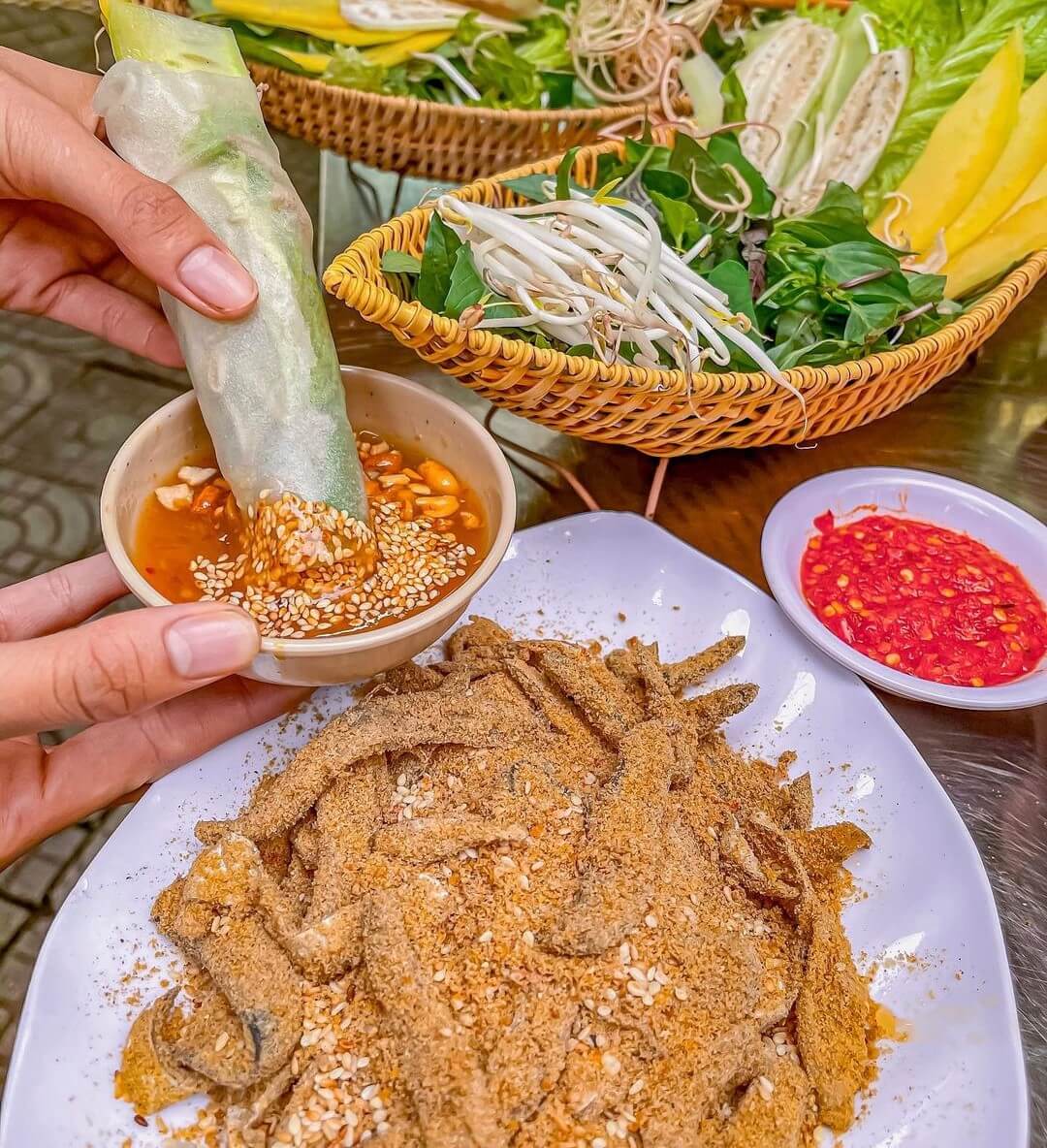
When eating, the dried salad is typically served with tightly rolled rice paper, inside of which you’ll find the dried fish salad, various fresh and delicious herbs, all dipped in a tantalizing dipping sauce. Photo: @trungbuii/Instagram.
You can enjoy the fish either rolled in rice paper with herbs or simply mixed with herbs and dipping sauce. Furthermore, the dish can also be served as a refreshing and spicy wet salad with fresh, tender fish immersed in a flavorful sauce made from famous Nam O fish sauce. A serving of Goi Ca Nam O costs around 3,33 USD, suitable for two people.
Banh Xeo Nem Lui (Sizzling Pancakes and Grilled Rolls)
The best places to find delicious Banh Xeo Nem Lui are on Hoang Dieu Street, Trung Nu Vuong Street, Chau Thi Vinh Te Street, and Dong Da Street. Prices typically range from 0,83 to 4,16 USD per portion, depending on the quantity of pancakes and rolls.
Central Vietnamese-style Banh Xeo is smaller in size, making it crispier and more convenient for rolling in rice paper. The accompanying condiment is hot soybean sauce, which has the right balance of flavors for dipping.
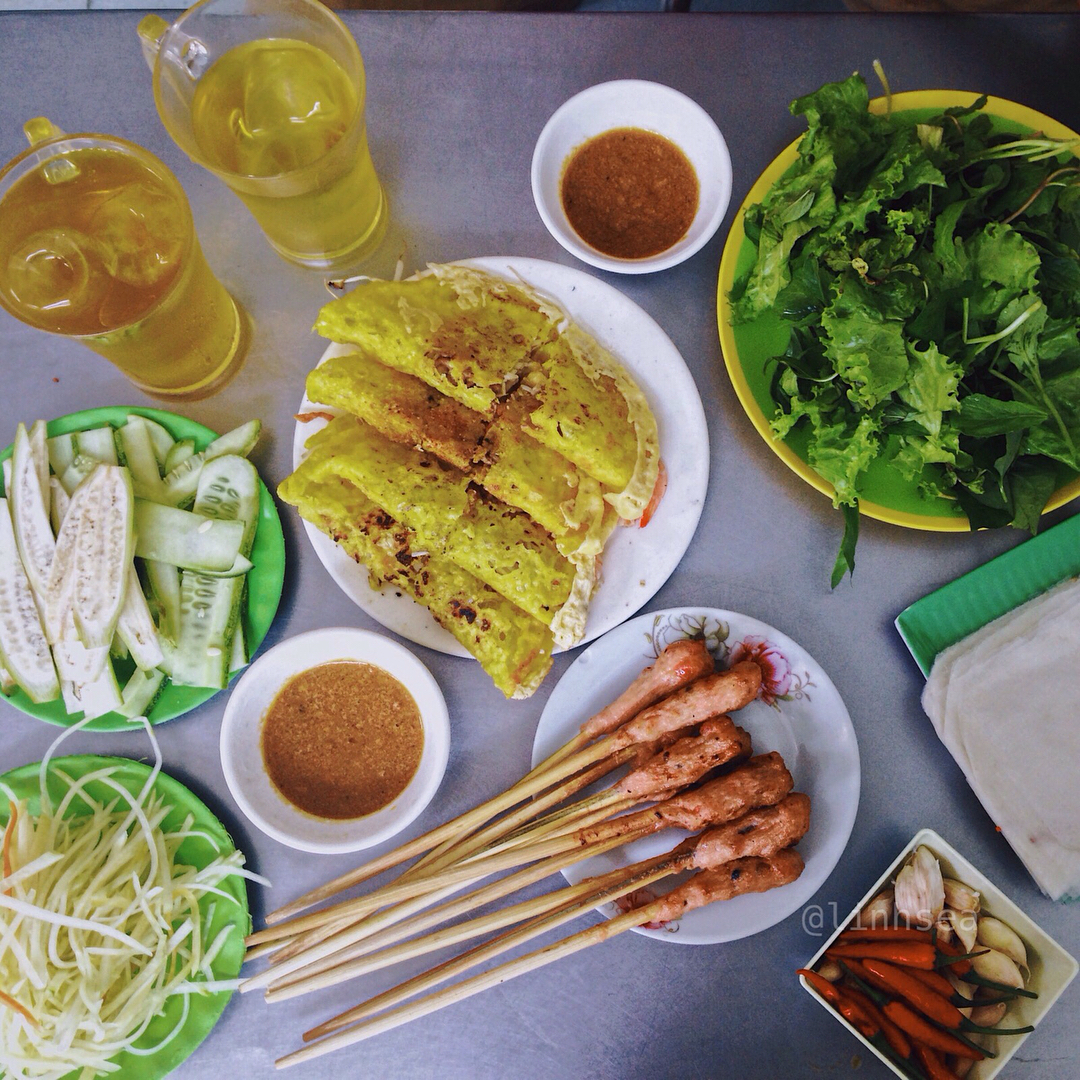
Photo: Linh Sea
Bun Mam Nem (Fermented Fish Sauce Vermicelli)
This is a popular and affordable dish in Da Nang. A full bowl typically includes pork, pork ears, beef, grilled pork meatballs, and nem (fermented pork rolls) along with various herbs and shredded green papaya or young jackfruit. The essential flavors of this dish come from the rich taste of roasted peanuts and crispy rice crackers.
You can try Bun Mam Nem at street vendors, sidewalk stalls, or at markets. Prices range from 0,62 to 1,25 USD per bowl.
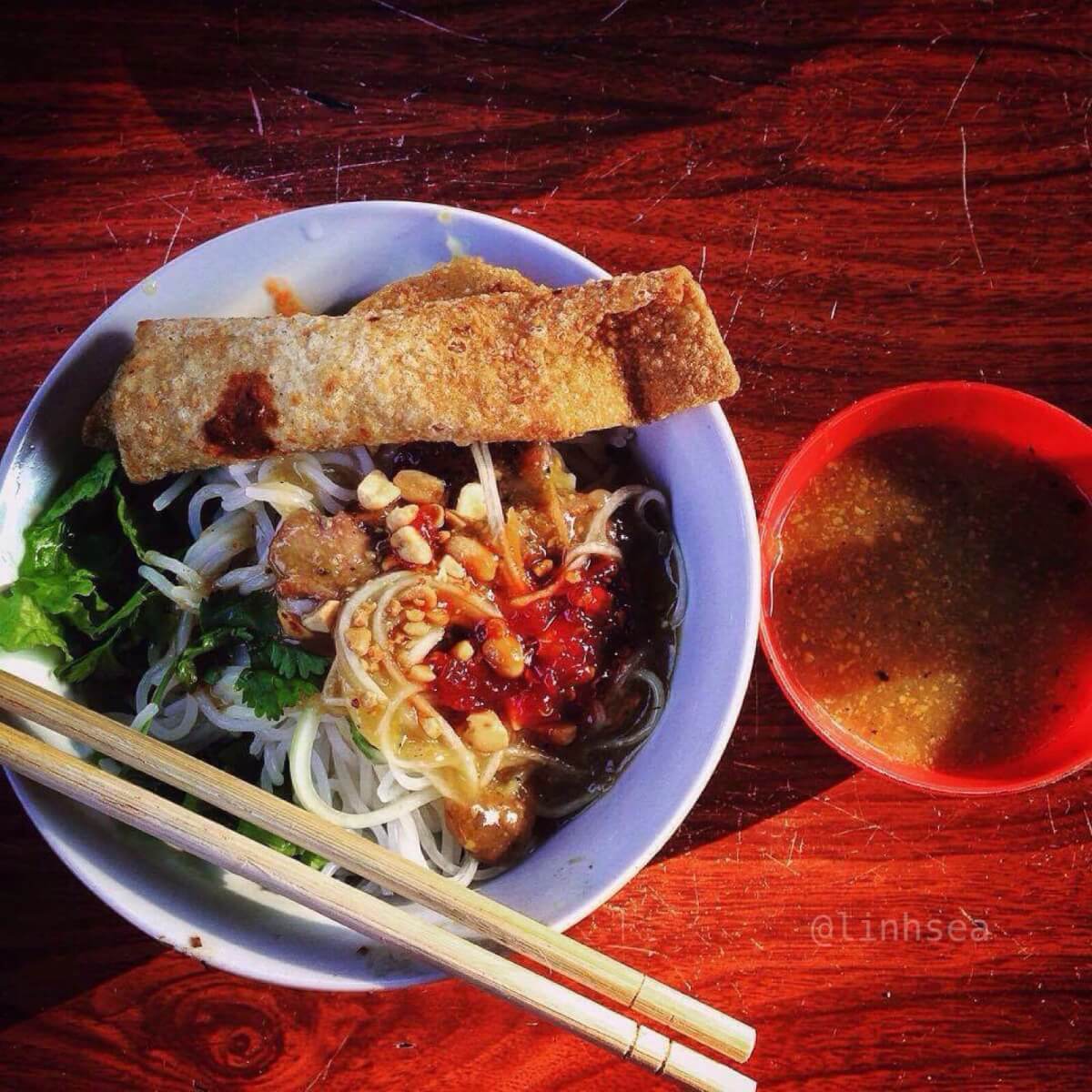
Photo: Linh Sea
Bun Thit Nuong (Grilled Pork Vermicelli)
Like Bun Mam Nem, Bun Thit Nuong is a familiar dish in Da Nang. It’s easy to find and costs about 0,62 to 1,25 USD per bowl. Bun Thit Nuong in Da Nang is usually served with a savory and slightly sweet sauce made from pig liver, ground meat, soybean paste, and other ingredients.
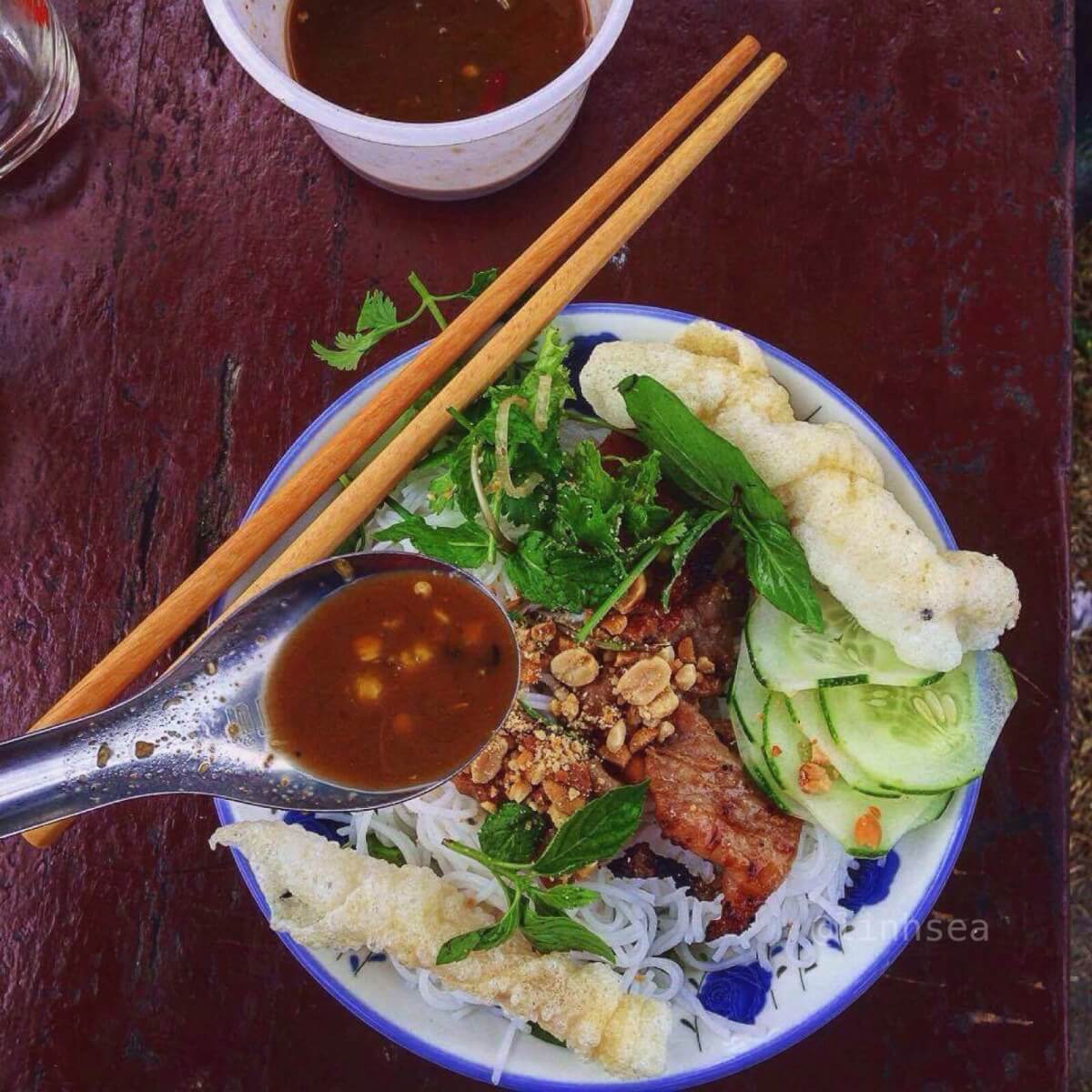
Photo: Linh Sea
Mixed Jackfruit
Mixed jackfruit is a favorite snack for many people. The main ingredients are young jackfruit, dried beef, dried buffalo, and roasted peanuts, all mixed together and served with rice crackers. A plate of mixed jackfruit costs around 0,83 USD.
You can find this dish in the snack alley on Bui Thi Xuan Street, under the Tran Thi Ly Bridge, or at an unmarked alleyway on Ly Thai To Street. If you’re a tourist, it’s a good idea to arrive before 5 PM to secure a seat and learn more about this dish.
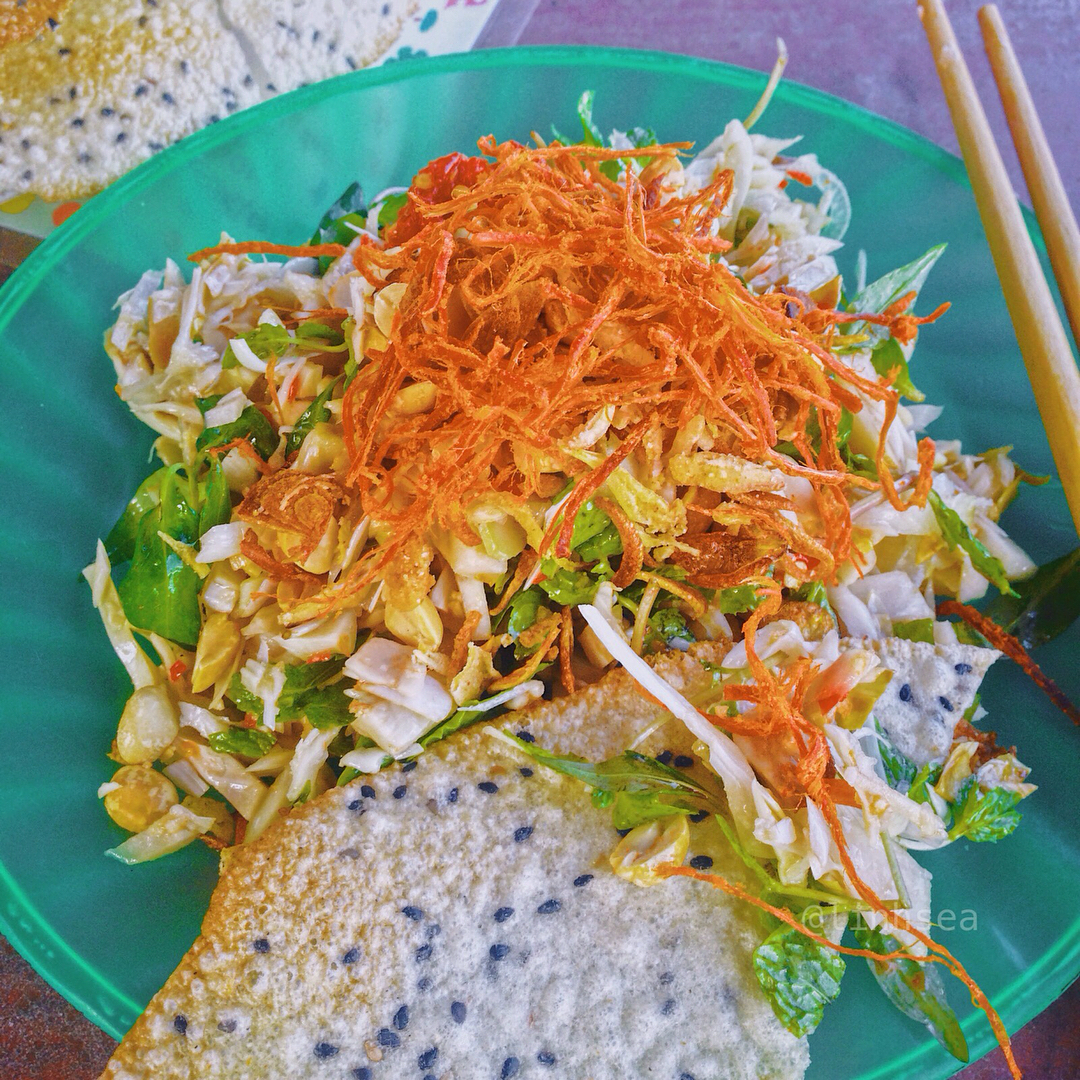
Photo: Linh Sea
Stir-Fried Snails
Stir-fried snails in Da Nang come in various flavors, from coconut sautéed to lemongrass and chili-stir-fried, or simply boiled with a fragrant broth. This dish is served with spicy pickled papaya according to the tastes of Central Vietnam. Prices range from 0,62 to 1,25 USD per portion.
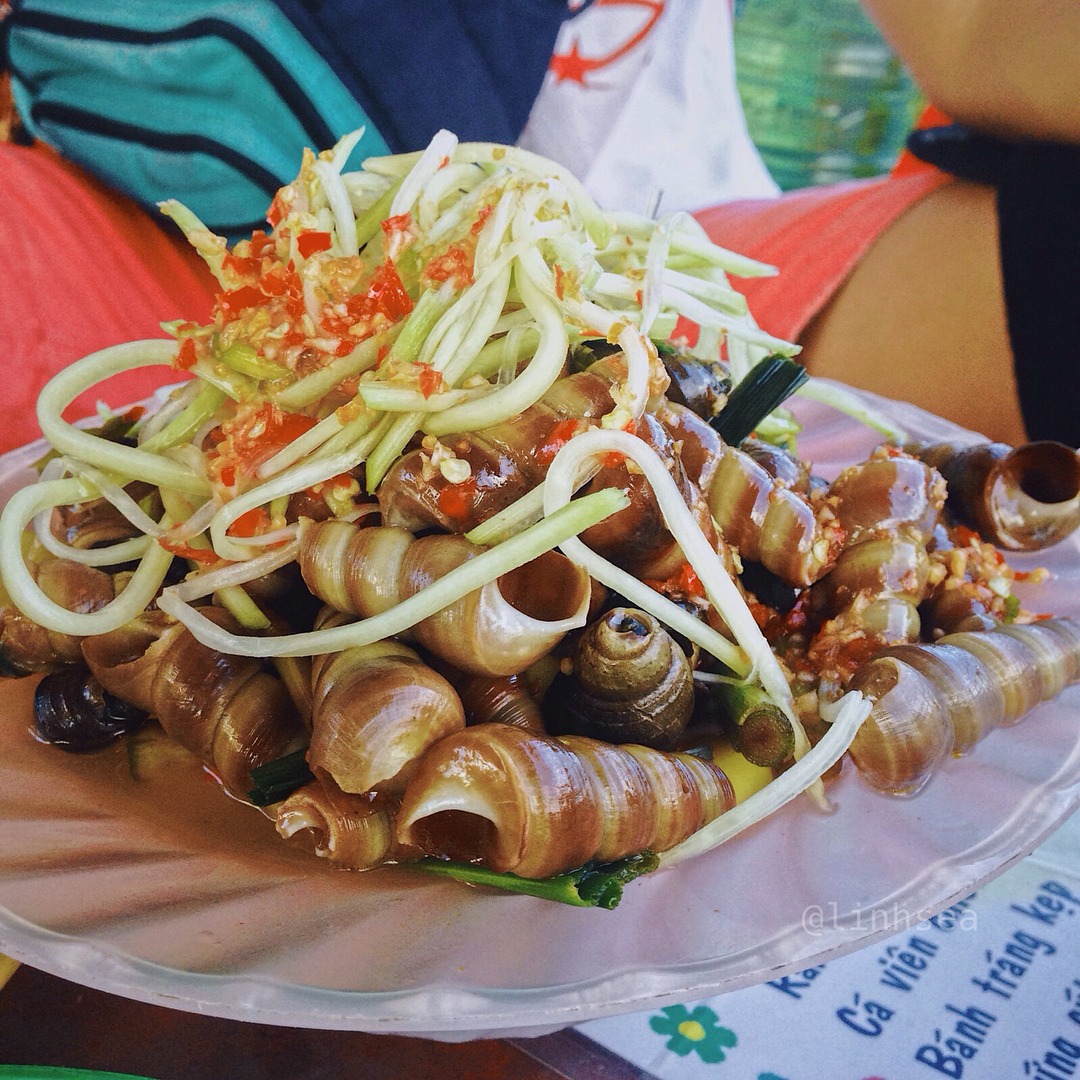
Photo: Linh Sea
Salted Yogurt
Salted yogurt is a popular snack, with each cup costing 0,042 USD. You can find it in an area at the base of the Tran Thi Ly Bridge.
The vendor usually brings out a tray of about 10 cups of salted yogurt along with a plate of white salt. You pay for the number of cups you consume.
Da Nang’s salted yogurt is soft and not overly creamy. Initially, you’ll taste the saltiness, followed by the sweetness of the yogurt lingering in your throat. Each cup costs 0,042 USD.
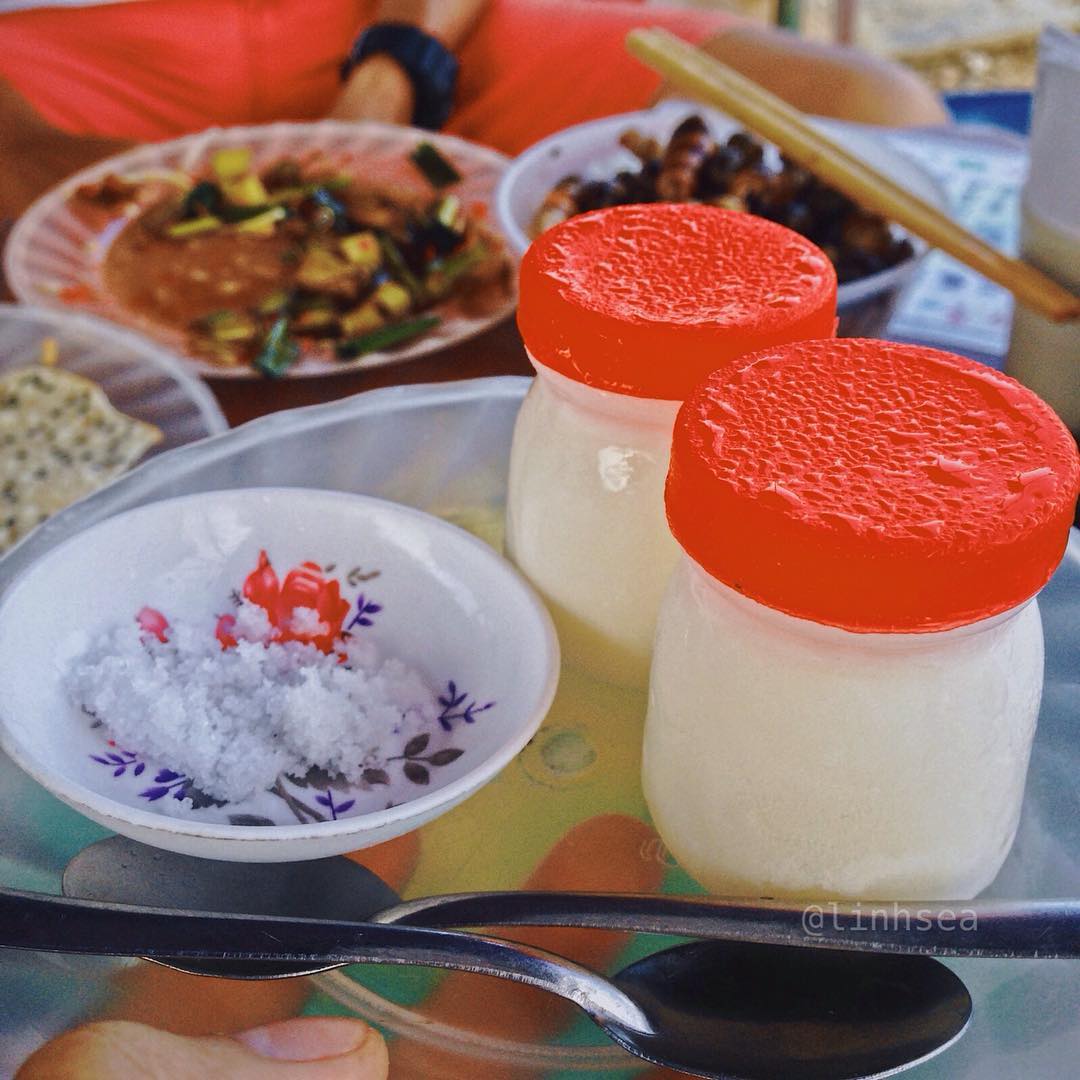
Photo: Linh Sea
What to Buy as Souvenirs
Tre Ong Chanh (Lime Leaf Cones), Banh Kho Me Cam Le (Sesame Candy from Cam Le), My Khe Seaweed, Nam O Fish Sauce, fresh or dried seafood, dried squid, and dried fish are some of Da Nang’s renowned specialties that are easy to find and suitable for packing in your luggage.
If you’re looking for souvenirs, you can opt for silk paintings, embroidery, oil paintings, decorative items made from stone, porcelain, wood, or artistic stone-carved products in the Marble Mountains area, as well as clothing made from silk and silkworm silk.
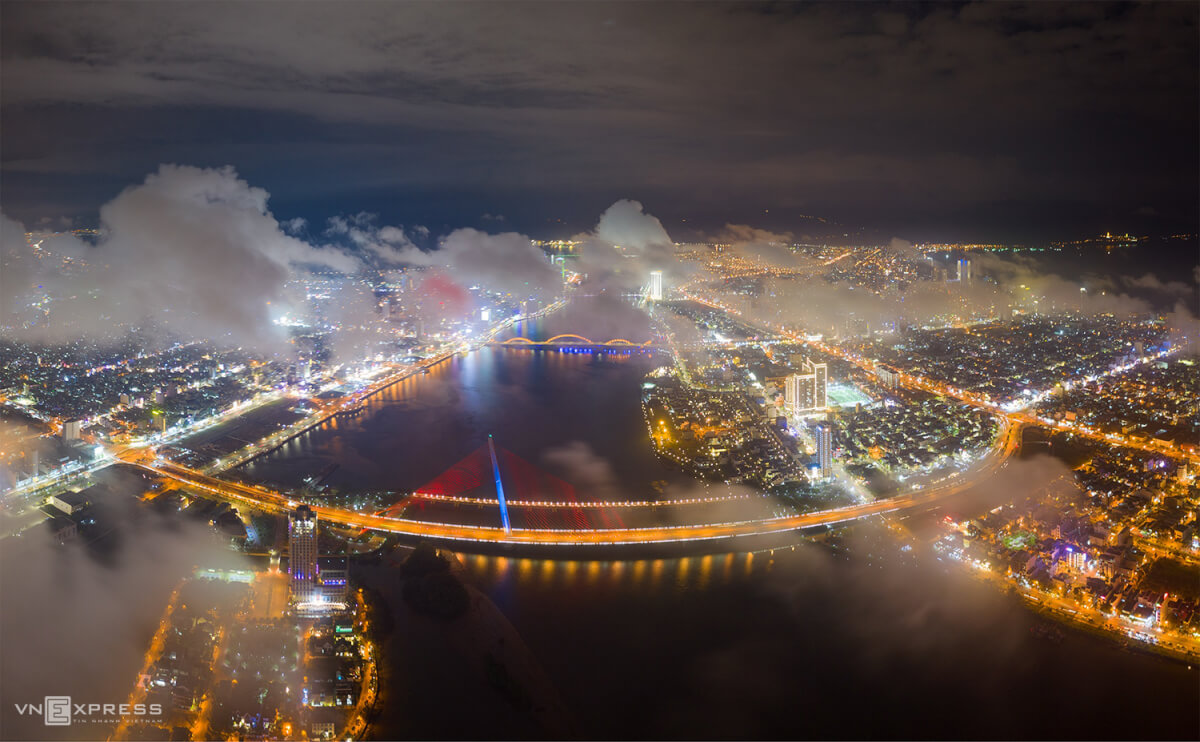
Photo: Nguyen Sanh Quoc Huy





